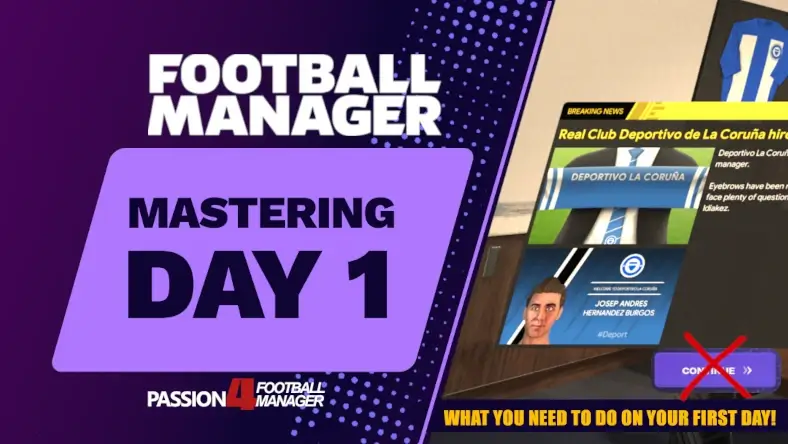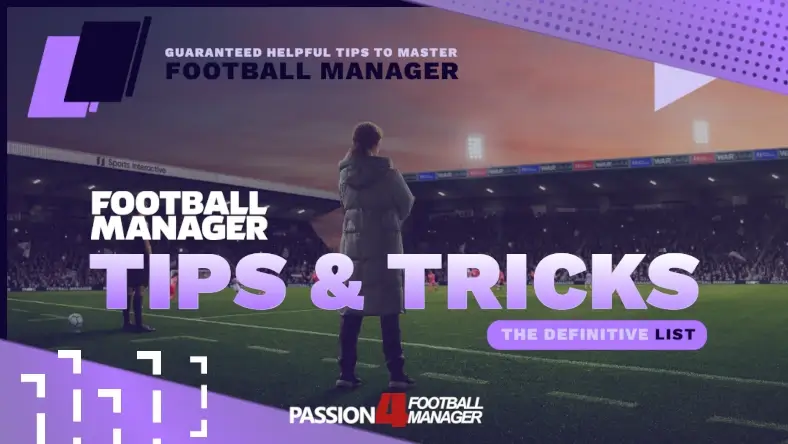Day one on Football Manager is a busy day for all managers. Whether you are new to the Football Manager-series or consider yourself a FM veteran, the first days after setting up your Football Manager save is crucial in your quest to achieve your long-term goals, and future success.
With lots of tasks and things to do, maximizing your day one routine is essential to get off to a flying start. Rather than clicking the continue button immediately, I want you to be patient!
Once entering a new club on Football Manager it’s decisive that you use strategical thinking and a well-thought-out plan to execute all the most essential tasks, in the most efficient way, before the season begins.
From the first thing you need to do once entering a new club to how to plan and execute pre-season training, what you do at the beginning of the season could have a major impact on what happens next.
Today we will help you maximize your first hours on FM24, and be more organized when you want to hit the ground running in your brand-new career. Here we’ll share our best tips on what things to do within the first hours of managing at a brand-new club, so you can maximize the first few hours!
In the process of mastering Day One on Football Manager, we will walk you through step by step what to focus on in the first days of your managerial career. Hopefully, it will help you to familiarize with your squad, your new players, and help you to settle into the club far quicker.
By writing this guide my objective is to give you a methodically plan which you can follow whenever you enter a new club. With the goal of easing the process of both starting a new save, as well as making the first days of managing into a more strategic process, that helps you to understand which chores to focus on, and when, this guide to master the first day of management will provide you all the tips and tricks to get you off to a flying start in your next career.
Table of Contents
Why you need a Day One Plan on Football Manager?
Nothing beats the thrill of starting a new save in Football Manager. The excitement to get straight into the action as quickly as possible can easily outweigh common sense as you are eager to lead your new club on the road to glory. It’s easy to get carried away by clicking the Continue button far too early!
That doesn’t mean it was a wise choice!
It’s no secret that I can spend hours having fun with laying the foundation for my save, and as pedantic it may sound, it can take hours before I hit the ‘Continue button’ for the first time. For me it’s all about being hands-on as early on as possible to get as most out of my coming save as possible.
The value of spending a few extra hours on the first day of management provides me with long term benefits letting me focus on other areas within my save in the coming weeks as the nerve of matchday and focusing on the next opposition will be in focus.
Whether your objective is to improve your finances and squad quality 3, 6 or 12 months ahead, the main job starts at Day One by being proactive rather than reactive by being hands-on and take advantage of every opportunity within your save as possible!
My approach to the first days of a new save is all focused on making the process of gathering as much information and data as quickly and effectively as possible. I feel it’s important to be methodical at this stage to ensure my save is in the best hands.
But let’s be honest!
Entering a new club or a new league can be difficult. Especially if it’s a new club to get acquainted with or a new league structure and nation to get to know of. The information and data to process about the club, its players and the nation may look overwhelming – reason why it can be beneficial to have a quick and effective “template” which you can use from save to save in order to get your new save off to a great start.
Over the years I feel I’ve perfected how I approach day one in Football Manager after years of expertise, trial and error, but still, I can use hours setting up my save, getting to know my players and backroom staff, and most importantly spend hours browsing the transfer market to identify possible transfer targets… and I love it!
However, I do understand not everyone is as pedantic as me.
Regardless of how thoroughly you wish to be, there are a few necessary tasks you need to complete regardless of your ambitions before you can finally embark on your new save!
That’s why I have written this guide on how to approach day one on Football Manager – helping you to become more experienced at entering a new club by unveiling the most essential tasks to complete before hitting the ‘Continue’ button for the first time!
So, without further ado, let’s take a closer look at how you can nail Day One on Football Manager & take a closer look at all the necessary tasks and objectives that can ease you into the process of entering a new save on Football Manager.
Football Manager Beginners Tips & Tricks
Get better at Football Manager with these 20+ guaranteed helpful tips to master FM24 / FM25.
Featuring beginner tips from us and our followers, this definitive list of Football Manager tips and tricks will be an essential reading for both Football Manager newbies and experienced armchair managers.
10 Tasks to Complete To Nail Day One on Football Manager
1. Required Tasks to Complete Once Entering a New Club
When entering Football Manager, you will be presented with several Inbox messages that will welcome you to the new club along with some Inductions that will help you to understand key aspects of Football Manager.
These steps are mandatory regardless of what you do next and provides a foundation for all the tasks and objectives we wish to achieve at day one.
When creating ‘Your Manager’ you have the option to untick the box ‘Teach me about key aspects of Football Manager’ which removes these Inductions about Scouting, Tactics, Training or how to sell players or understand how to setup set-pieces on Football Manager. By clicking the Question mark button, you can always take these Inductions at your own pace or restart these mini tutorials if there are certain things you don’t quite understand.
Before continuing our guide to mastering day one on Football Manager there are some actions you need to take for us to continue the process.
Apart from going through these Inductions, there are several other things you will be presented with that requires your attention before we can delve into our guide to day one on Football Manager.
At the start the directors will welcome you to your new club by delivering several Inbox Messages that gives you more information about the club, such as.
- Give you the opportunity to schedule a press conference to meet the media for the first time and send out some messages about your project to the fans [Recommended]
- Set up an intra-friendly against your B-team or Under-21s to get acquainted to your players, their strengths and weaknesses and help you to build relations to your squad. [Recommended]
- Supporter Profile & the fans’ influence on the board
- Club visions & board expectations
- Contracts due to expire
- Tactics Creation [Required]
- Squad Registration rules
- Pre-Season Preparations
Following I’ll give you a quick insight into the different required steps to take once entering a new club and what to think about, if any, that can give you an early advantage for the coming seasons ambitions and success.
1.1 Club Visions & Board Expectations
The Club Visions and expectations meeting between you and the board is the first required actions you need to do. In the Club Vision and board expectation meeting you will get a better idea of what’s expected from you both in the short and long-term, the club’s objective relating to on and off field performance, as well as being presented with the club’s 5-year plan and what’s desired by the board to keep their trust and happiness.
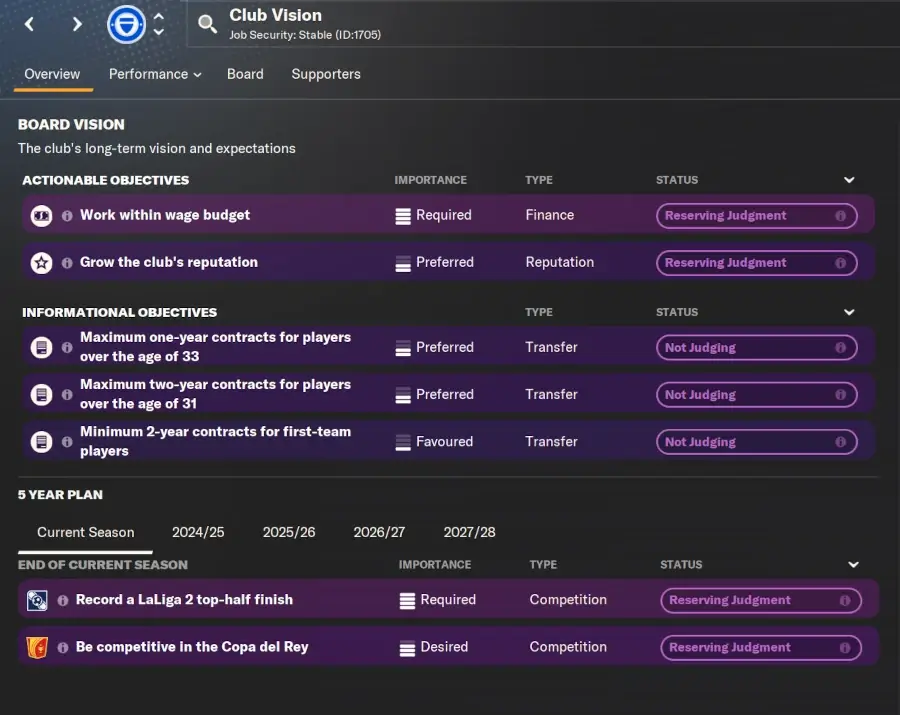
The club visions might set certain limitations and directives on how you would go about scouting- and recruiting players, manage the club’s finances or what’s desired by the board to deem your on- and off pitch performances a success.
As you will notice, the board will judge you upon both the actionable visions and the more informative visions that relates to your transfer and recruitment policy. For instance, some boards will prefer to sign players under or at a certain age, whilst other might prefer you to sign players from certain nations or regions around the world. Some might even favour that you do only sign players with a certain contract length.
What you will discover is that different clubs have different club visions and board expectations – making managing at different clubs a unique experience. Each board have different levels of patience, expectations and ambitions.
In the board meeting you can negotiate and suggest objectives and long-term goals. However, at the start of a new career you have limited opportunities to influence on the proposed visions by the board but as you gain their trust and improve your reputation by achieving success on- or off the field, you might be able to affect the club’s visions that aligns to your football philosophy at the end of the season, or at contract negotiations.
What’s important to keep in mind is that you will be judged upon the agreed visions and objectives – meaning you should try to meet these demands to keep the board happy. If not, you might come one step closer to get the sack.
As your season progresses, you can always keep track of your job security and the boards happiness with your management as they will give you a grade from F to A+ in matters like Squad building, Transfers, On-pitch performance, Tactics and how you meet the expectations from the club visions.
You can find the Board happiness and your job security by browsing the Club Vision section and select Performance.
Within the ‘Board’ overview, you can make board requests, adjust the transfer and wage budget, or assess data relating to agreed or denied board requests and which ones are pending.
1.2 Contracts due to expire
Besides meeting the board to agree upon what and how your board shall judge your performance as a manager and getting an overview of the long-term ambitions of the board, your Director of Football (if the club got one), will send over a list of players in the last year of their contracts.

Players in the last year of their contract will see their transfer value decreasing as the player reaching the final stages of his contract. At the same time, other clubs can approach to sign these players when there’s six months left of their expiring contract – potentially resulting in loss of income if you prefer to sell them.
Spending some time over the coming weeks to judge whether these players are worth to keep, or sell, is desirable.
At this early stage it’s useful to browse through the profiles of each player with expiring contracts and locate players that might be sold for a profit a few years in or developed into potential future first team starters.
Unless you have a wonderkid or a really great player that you can build your squad around for the next few years, there might be suitable prospects to try to sell to reduce the club’s wage bill.
At this early stage, all you got to judge their abilities are star ratings relating to current ability and potential, player attributes, transfer value and/or wages which can help you decide whether to delay the decision, ask your Director of football to negotiate renewal or offer a new contract.
Personally, I prefer to offer a new contract to potential key players and talents with huge potential immediately to try to avoid losing great players that could generate funds in the future if sold. Besides that, entering private talks and renewing contracts might help to build future positive relationships to important figures within the club, such as key players and generational talents.
Offering a new contract to players and hot prospects who have acquired interest from other major clubs is a key objective for me at day one, especially if the finances are good and these players fit the club profile. In fact, I would hate to see great players leaving because of an administrative error. A mistake I’ve done previously as I oversaw Joao Neves, who at the time was playing for the B-team and forgot to give him a new contract – resulting in him not wanting to head into a contract renewal negotiations at the end of the season.
1.3 Tactics Creation
One of the biggest decisions you must make at day one is how you want your team to play and what type of tactical style you want to incorporate at your new club. All though this is a subject on its own and there’s a lot to learn about how to create a tactic on Football Manager, taking the tactics induction can learn you about key aspects of tactical creation.
To proceed with our day one strategies, I would like to suggest that you simply create a basic tactic. Which formation and tactical style you choose at this point doesn’t matter as we will have to make further adjustments to the tactic once we have come to learn the squad’s strengths and weaknesses and the positional abilities for your players, which will be one of the essential tasks at day one on Football Manager before we hit the Continue button for the first time.
What’s important to keep in mind is that what playing style you wish to incorporate will have a huge impact on the type of training schedules you must select & what training sessions to prioritize to improve the performance of your players on the pitch and increase the tactical knowledge about your football philosophy.
However, at this early stage you can come a long way by selecting the recommended formation and tactical style your assistant manager suggests with a ‘thumbs up’ icon.
The assistant manager will hereby suggest a formation and tactical style that fits your current squad and the type of players at your disposal when entering the new club.
1.4 Squad Registration Rules
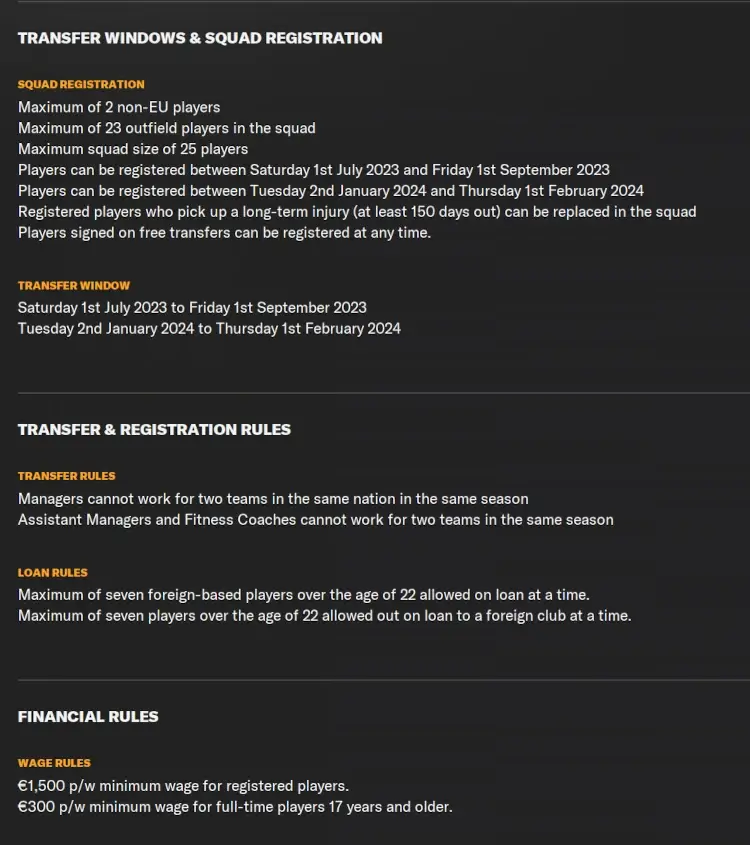
If you ask any keen Football Manager player what mistakes they’ve made, I’m sure overlooking how team registration rules or competition rules affect us in the game, both in terms of scouting, recruiting and team selection, is a recurring theme for all of us.
I think I can speak for all of us when I say we have all done the mistake of forgetting to familiarize ourselves with the number of maximum non-EU players, or foreigners (‘Fgn’), allowed to register in your squad, or how many home-grown players or players under the age of 21 required to select within your league’s squad registration before the registration day comes.
Each nations’ league rules will differ relating to how many players you can sign on loan, from outside EU or foreign nations, and how many senior players your squad needs to meet the minimum requirements.
Getting to know the league rules is necessary before heading to overseas continents to sign a lot of foreign wonderkids at a relative high cost, or you try to improve your squad with several loanees. Perhaps you overlook your youth teams and forget to develop enough home-grown for the first team and find yourself in the position where you can’t meet the minimum squad registration rules and must pick a limited squad because you do not have enough players coming through your club under the age of 23.
1.5 How to find the league rules & what’s essential to keep in mind?
To familiarize yourself with the competition rules you can quickly find the squad registration rules and transfer rules bye either going to;
A) Competition > Overview > Rules
B) Squad > Overview > Registration
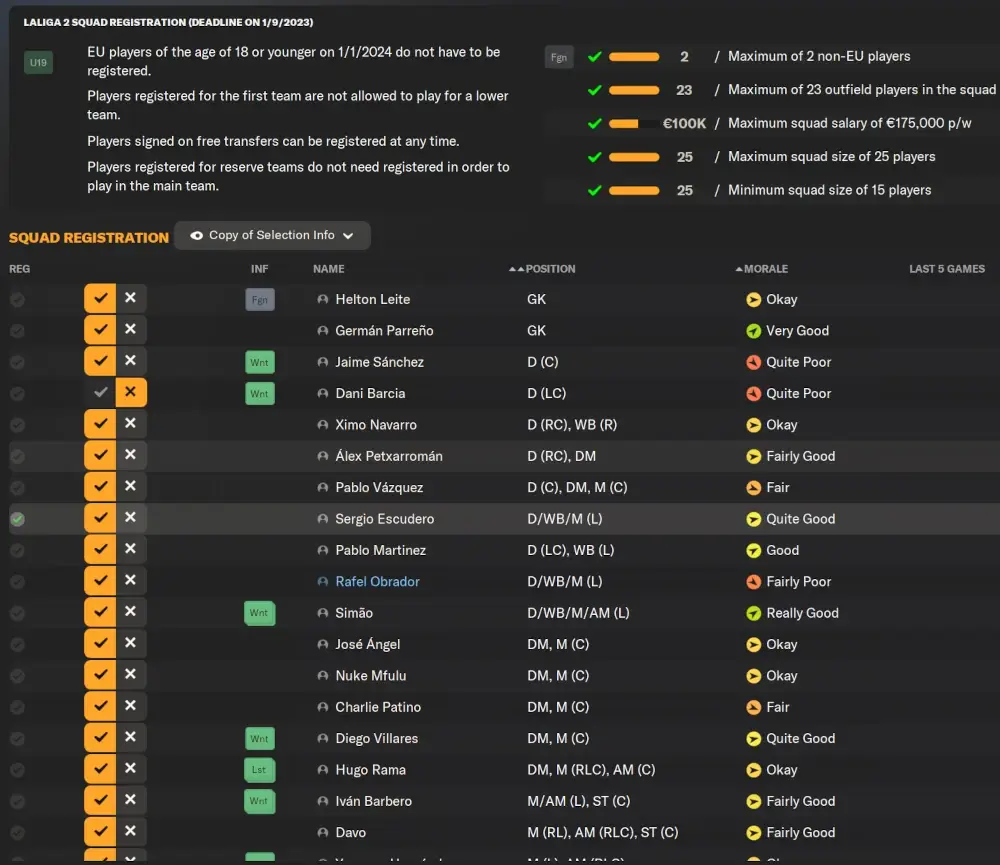
Here you should pay attention to:
- Maximum non-EU players allowed to be registered
- Maximum/minimum squad size
- Maximum number of foreign players allowed on loan
- Number of players on loan allowed to be selected in the match squad
- Maximum/minimum of homegrown players or players trained at the club required to be selected
- Work Permit Rules e.g England’s transfer rules of foreign players
As a newbie to Football Manager, I understand it’s a lot to take into consideration so early on but spending a few minutes to familiarise yourself with the squad registration rules will help you over the coming season.
You will hate to come in the situation where you can’t register your key transfer target as you fail to meet the league rules. Not only will the player become unhappy with your treatment of him by not registering him, but the relationship with him might be ruined for the long-term which forces you to put him up for sale or send him out on loan before he has made his debut.
Then, other teammates might get behind his disgruntlement which might see your squad turn the back on you and the entire dressing room atmosphere and club cohesion suffers – something that will lead to drop in morale and further negative on-pitch performances.
After completing these required steps, you need to take once entering a new club, it’s time to take a closer look at the essential tasks to complete before hitting the ‘Continue’ button for the first time.
2. Sort out Staff Responsibilities
Customizing the staff responsibilities can be done already when setting up Your Manager profile but you can also delegate and handle the different departments within your club at any point possible.
To do so, simply go to Staff and head over to the Responsibilities section.
Here you’ll get a brief overview of all the different staff responsibilities that you or your staff oversee, split up by the different area of the game – from hiring and firing staff to media and scouting responsibilities.
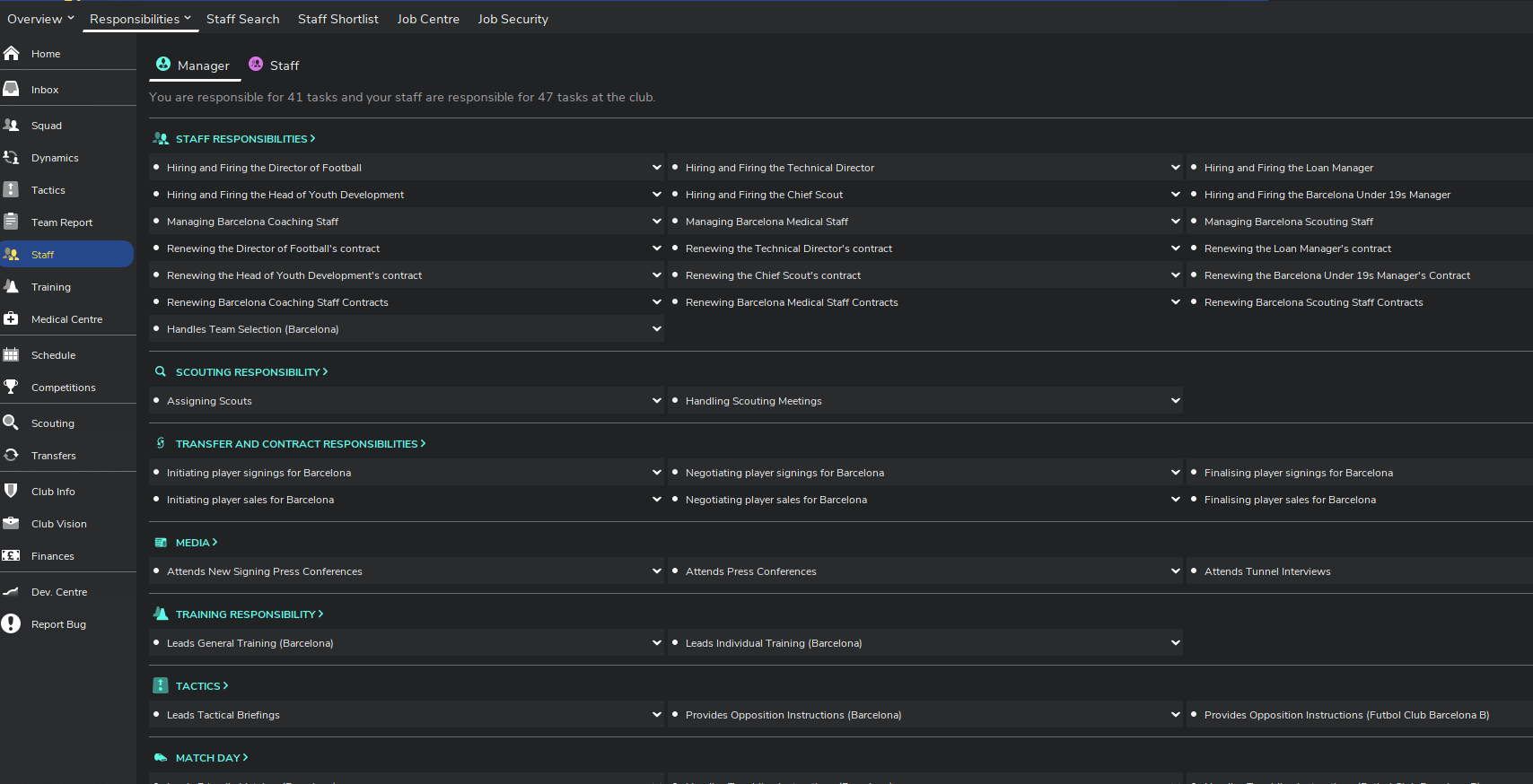
The overview can look quite overwhelming so use the drop-down menu items to pick the different categories to customize the staff responsibilities for that area of the game.
For the first day of management, I recommend spending some time familiarizing yourself to the different staff responsibilities and ensure that you have delegated everything that’s not important for you to enjoy the game.
If you’re new to the game, you can delegate as much as possible until you feel more comfortable handling training, media, such as press conferences, or assigning opposition instructions yourself.
As you go through and adjust all the different responsibility categories, make sure to remember to click Confirm once you’ve made any changes to the default settings.
Remember! You can make changes to the Staff Responsibilities at any point within the season. As you become better at Football Manager and gain confidence about the different departments of the game, head back and edit anything you desire.
Although we have taken a closer look at the different staff responsibilities in Football Manager in a previous guide, let me quickly go over which responsibilities I recommend you handle yourself.
2.1 Recruit Staff
In Football Manager you’ll have the opportunity to let your directors, such as the Director of Football, or other staff, to handle the recruitment of other staff. From hiring and firing coaching staff for the Under-19s squad to handling squad selection, there are a lot of options that may have a huge impact on your career.
To ensure you can establish a football philosophy that runs through the entire club, it’s important to take charge of the recruitment of staff yourself. You don’t want to be in the position where your DoF fires your head of youth development, or sign youth coaches who doesn’t fit your club’s profile.
Or even sign a lot of staff that both isn’t good enough to improve the backroom staff or staff with the wrong qualities to fulfil the duties you need a staff member for.
Personally, I favour to be rather hands-on regarding recruiting staff and handle most of the responsibilities of hiring and firing staff myself to ensure better control of all matters relating to staff management and club building.
You should prioritize handling:
- Squad Selection (you will still be able to get selection advice from your assistant manager about future starting XI’s). You can delegate squad selection of your youth team to your Reserves- or U18s Manager.
- Hiring/firing all First Team Staff as well as the Manager for the Reserves or Under-18 squad.
2.1.1 Undertaking coaching courses
If you scroll all the way to the bottom of the Recruit Staff section, you can even decide who shall decide when or which staff shall undertake coaching courses. By default, this is assigned to either the Technical Director, which is his primary role, the Director of Football, or other club Directors.
The one in charge of this requires good levels of Judging Staff Ability, but who knows your plan better than yourself?!
Regardless of who is in charge of overseeing coaching courses you can request the board to send a specific coach out to improve their coaching experience.
This is often a recommended actions for any youth coaches and first team staff with lower than Continental Pro licence, as that’s the level we’ll desire of any coaches working in the top leagues.
By increasing a staff’s coaching qualifications, they will increase their current abilities and thereby their staff attributes. Just like players, they will also develop their skills if they have unfulfilled potential by spending time on the training ground.
A young coach with huge maximum potential being in charge of Defending – Tactical will improve their Tactical Coaching and/or their Defending Coaching as the season(s) progresses.
2.1.2 Contracts
You enter a new team to only discover that most of your staff are on an expiring contract. At the end of the season is closing in, you’re provided with a long list of staff you must negotiate a contract extension with. A job that can take hours and feel quite underwhelming.
I’m sure we’ve all been in this position. Boring but necessary!
If you wish you can hand over the massive job of negotiating contract renewals to your Director of Football or Technical Director.
2.2 Advices & Reports
Football Manager provides a lot of in-game tips and valuable information that can help you to take your management to the next level. Throughout the game, you’ll get feedback, advice and reports delivered to you through Inbox Messages and conversations.
In Football Manager, there are eight different Advice Categories splitbetween three different topics:
Transfers & Contracts:
- Recruitment
- Providing Scout Feedback
Player Reports:
- Development
- Provides Player Reports
- Provides Youth Development Information
- Providing Loan Feedback
Misc:
- Coaching
- Staffing
By clicking on the name of the person currently in charge of delivering a specific type of advice or report, you’ll be able to see what staff attributes the person requires to be in charge.
If you click on each of the specific advice categories, you’ll be able to determine where you want those staff advices delivered. This little trick can both save you a lot of time by deactivating certain reports, or enable you to get valuable feedback about a range of topics relevant to the main advice category.
What you’ll find useful is the opportunity to ask your staff to send certain reports and advices directly to your Inbox, or include them in the next Staff Meeting to address the concerns at regular interval.
At the start, it’s important to select the appropriate staff member to deliver these advice and reports. The better their skills the more you can trust their feedback.
Take notes of any staff who are in charge of delivering reports with poor abilities to provide accurate feedback and remember that when entering staff meetings or scouting meetings.
On top of this screen pay attention to the opportunity to select the frequency of reports and meetings. Personally, I favour to keep Staff Meetings at a monthly interval, whilst advice on Player Targets and Analyst Reports should be delivered more frequently – every week or every fortnight.
Below is a simple table of what type of staff I prefer to be in charge of each of the different advices categories:
| Category | Staff Role | Key Attributes |
|---|---|---|
| Recruitment | Chief Scout Head of Performance Analyst | Judging Player Ability Judging Potential Ability Analysing Data |
| Providing Scout Feedback | Chief Scout | |
| Development | Head of Youth Development | Judging Player Ability Judging Potential Ability Working with Youngsters |
| Provides Player Reports | Assistant Manager | Judging Player Ability Tactical Knowledge |
| Provides Youth Development Information | Head of Youth Development U19 Manager | Judging Player Potential Working with Youngsters |
| Providing Loan Feedback | Loan Manager | Judging Player Ability People Management Analysing Data |
| Coaching | Assistant Manager | Attacking- Defending- Tactical- Mental- Fitness- Set-Piece Coaching |
| Staffing | Technical Director Director of Football Assistant Manager | Judging Staff Ability Analysing Data* |
2.3 Player Contracts & TransferRoom
Just like maintaining control of staff recruitment, you can also delegate or handle the responsibilities of ingoing and outgoing transfers. Here you’ll be provided with several options from initiating signings or sales to finalising the deals.
Who you should sign is often a matter I like to be in control of myself. However, if you struggle to sell transfer listed players or find loan moves, you can delegate the responsibilities of handling outgoing transfers to your Director of Football, as long as he has above average skills in Negotiating.
Personally, I could recommend you to be in charge of Initiating Player signings / sales, as well as the negotiation process, but leave the final steps to the most appropriate staff member.
What you delegate or handle in this department is very much up to your personal preferences but if you want to ensure your club buys the best players that fits your team, you should try to take control of as many aspects as possible.
You do not want your staff to spend money on a player who will never fit into your team, either due to personal preferences by you or according to his skills and tactical abilities (position, role/duty and other parameters which determines whether the player could be labelled as a perfect signing.
What shall happen when Transfer listing or putting players up for loan?
In the regard to this topic, I would recommend you to head over to the third column within Transfers & Contracts, to the Offer via TransferRoom tab.
On this screen, you can set up some pre-determined requirements when offering out players either via the TransferRoom for transfers or for loans.
This automates the process of offering a player out via the TransferRoom.
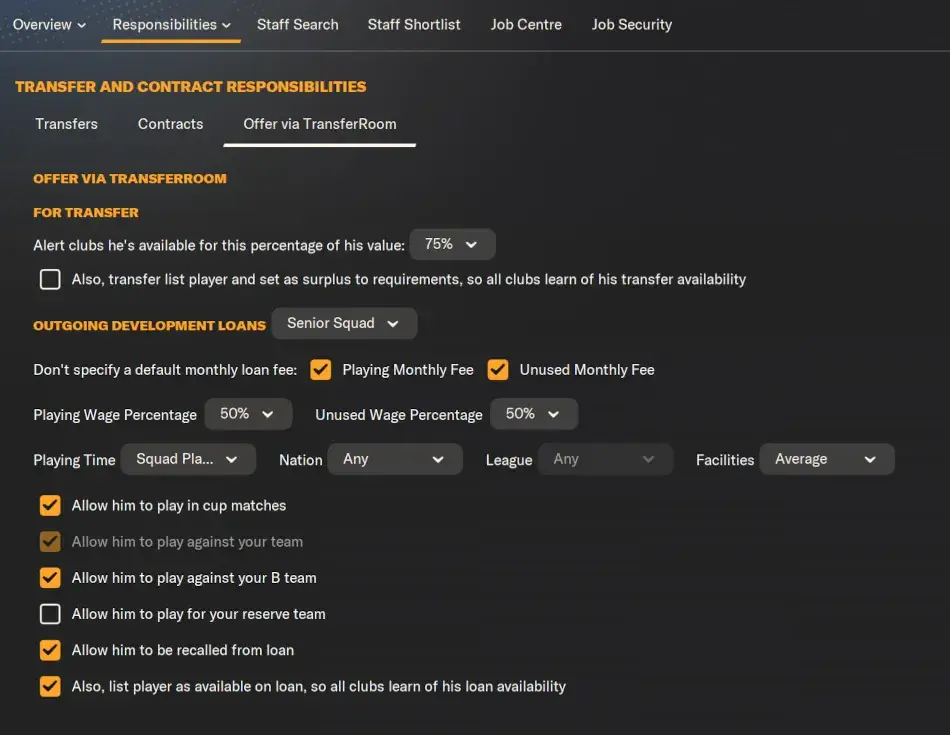
You can set the percentage of his current transfer value the player shall be available for, or determine the minimum required playing wages and unused wage percentage which is acceptable to you to loan a player out.
What can be advantageous is to determine the minimum levels of training facilities to accept a loan move. Since loan moves can be a highly effective development strategy, you should ensure the clubs who are interested in a loan move has as good training facilities as possible. Then, it’s important that he receives game time and enough match minutes to progress.
Here’s a screenshot of my favoured customization of what shall happen when offering players out via the TransferRoom.
2.4 Match Day Responsibilities
Finally, you can tailor how much you want to take control of in regard to completing the match day experience. In this section you can let your staff take control of team talks to try to motivate the players to step up their performance’s, pre-match or at half-time, for both your first team and the Reserves.
If you delegate team talks to your backroom staff, you will experience that this feature is “removed” as you won’t be able to make any adjustments or changes to what he decides to say.
The staff leading team talks requires Motivation and People Management in order to say the correct things that improves the players morale and happiness rather than decreasing it.
Within this screen, you should pay attention to two different options:
- Let backroom staff arrange friendly matches for both the first team, Reserves and Under-19s
- Automatically make unfit first team players available for the B-Team or Reserves, and when the players shall be made available.
In this event, I would recommend you take charge of setting up friendly matches for the First Team yourself to both find opponents at the level you desire and according to the plan we got for the pre-season.
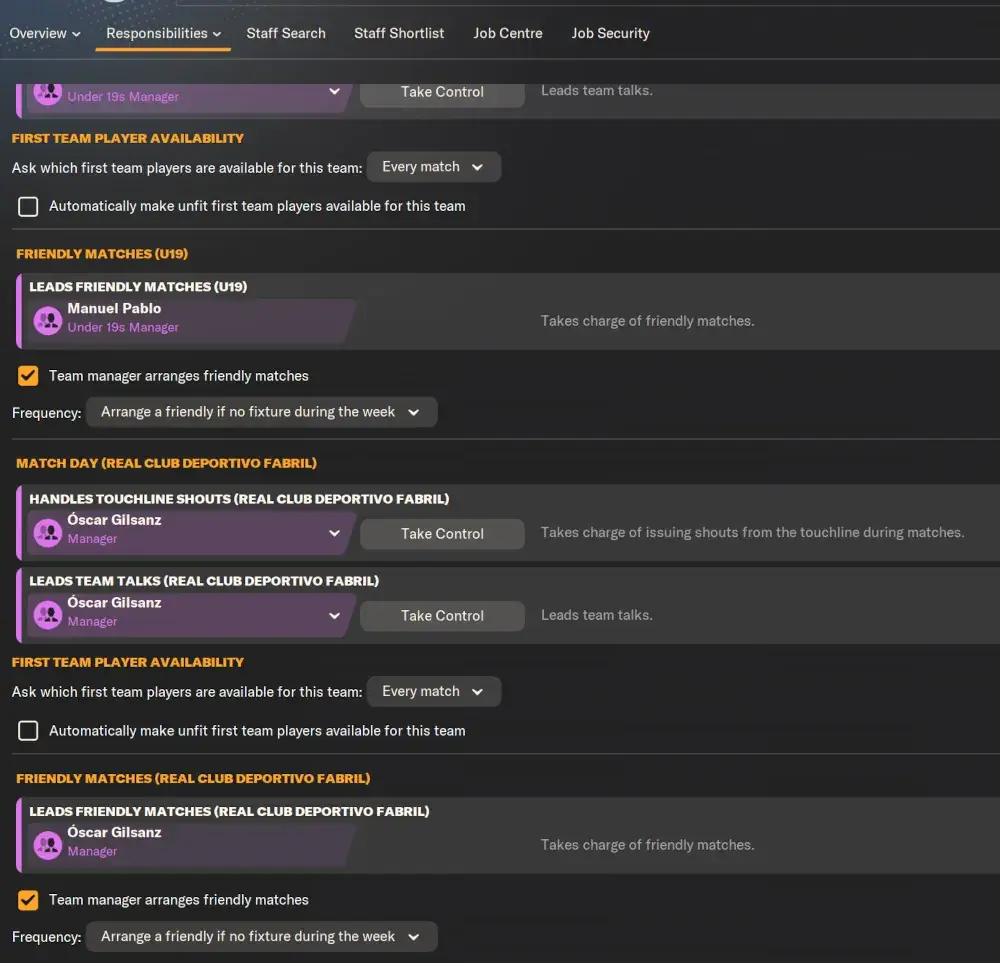
Then, I favour to let the Under-19s Manager or Reserves Manager set up friendly fixtures if there are no fixtures during the week. Our training schedules megapack for youth teams is created in a way that enables the backroom staff to set up friendly matches on Saturdays if no competitive fixture is arranged.’
Regarding making unfit players available to the B-Team or Reserves, I recommend editing the option from Every Match to ‘When First Team has players in need of match sharpness or not picked in the match squad’.
But be aware that you might come in the position where you suddenly miss a valuable player at First Team match days if you forget to include him in the match squad.
However, this setting ensures the player receives valuable match practice if he’s coming back from an injury or are struggling with his form.
Basically, you must weigh up the pros and cons before determining what to choose for this setting. I wouldn’t disagree if you wanted to decide yourself when to make the player available for one of your youth teams by setting it to ‘Never’.
This gives you a lot more control over who will be available to be selected for the match day squad selection.
To make a player available for the Reserves or Under-19 squad selection, go to a player’s profile. Click the Development drop down menu and choose Available for Next Match, or Until Match Fit.
2.4.1 Opposition Instructions
Many of you might find the opportunity to delegate the responsibilities of Opposition Instructions to a member within your coaching staff useful.
Opposition instructions in Football Manager enables you to target specific key players, positions or specific opponents’ strength or weaknesses to try to reduce their impact within the game. It can be a great strategy, if you know how to use opposition instructions, to try to get the better over your opponents.
Although there are some recommendations on how to setup opposition instructions to improve your team’s pressing, your assistant manager will provide his advice on how to target certain opponents based on their performance and data.
If you leave it to your assistant manager, you will basically let him implement the desired opposition instructions, but you’ll be able to provide or customize the opposition instructions on top of or instead of the assistant manager’s recommended setup.
The staff member who provides opposition instructions requires:
- Tactical Knowledge
- Judging Player Ability
- Analysing Data
Rather than spending more time going through all the different options you will discover within the Staff Responsibilities, we will touch upon the relevant responsibilities to take control of in under the relevant chapters for training, scouting or tactics.
3. Know your Squad! Analyzing the Squad depth
Analyzing your squad and planning for the future is an important step to take! The key is to spend the first hours within your new save to get to know your squad. The main aim is to learn about the true quality of your squad and its potential!
In this process you will need to get to know your squad in general as well as learning about the individual players within your squad and what they are capable of.
This is useful knowledge we need before we’re able to create the best tactic that fits our players, or make some final decisions upon the short-term objectives,
Setting the goal of winning the title in the first season will be unlikely if your team will battle in the relegation zone, or you find yourself in the position with worse players than the top 6 teams in your league.
Then, choosing an attacking tactic might not be the best if you’re team is expected to finish in the relegation zone. On the other hand, you can’t expect immediate success if you wish to install a possession-hungry style of football if your players lack the technical abilities and creativity to dominate the opposition.
Analysing the squad’s overall strengths and weaknesses, by considering the players’ individual skills and positional abilities of all your club’s players, must be one of the first things you do when entering a new club.
In Football Manager, we can divide this process into:
- conducting a squad analysis which provides you with an overview of the team’s overall characteristics of what tactics may fit your players and the playing style the squad in general might be best suited to.
- Analyzing the player’s individual capabilities to better understand their current playing level, which tactical role they will perform the best in and how they may fit within your selected tactics relative to their player attributes, traits, positional abilities.
- On top of that comes getting an overview of the players age and abilities relevant to their transfer value, contract status and wages to determine how they may fit into the future planning of your squad according to the chosen tactical philosophy
What tools to use to Analyze the Squad or Its Players?
To get to know your players, Football Manager has several different tools available to you throughout the game to enable you to assess key information about your team and its players.
In fact, Football Manager enables us to conduct a squad analysis in three different ways;
- Assessing the information within the Squad Planner such as getting to know your team’s abilities through the Team Report or learn about the Squad’s depth
- Browse Player by Player & familiarize yourself with the individual capabilities by assessing the information within Player Profiles along with Coach Reports to identify strengths and weaknesses
- Taking advantage of the Squad Overview & its opportunities to customize specific squad views.
Frankly, the information within these screens can be of great help to make some final decisions on suitable formation, what type of football that fits your current squad, or who might be suitable prospects for competitive matches.
On top of that, you’ll even get insight into how your squad relates to your opponents and might identify weaknesses within your squad you should prioritize in the recruitment of potential signings, for instance when creating recruitment focuses or for long-term planning of your squad.
Below I will quickly run you through some of the methods you can use to get a deeper understanding of your players abilities and identify positions to strengthen.
3.1 Assess the Team Report Card
One of the basic methods to assess your players skills is to take advantage of the information compiled by the Assistant Manager within several team reports.
In Football Manager your Assistant Manager will gather information such as the;
- The Basic Assistant Report aka Team Report Card
- Best XI
- Squad Comparison
- Stats
Assistant Report
The Assistant Manager’s Team Report will take a closer look at the overall squad abilities relating to notable player attributes and reveal certain strengths and weaknesses within the squad that might help you to decide upon the tactical style that fits your team.
You can use this information to determine what type of football your players are best suited to when creating your tactics. Personally, I use this information to see if the football philosophy I wish to incorporate at my new club will become a quick or long-term process.
On top of that, the team report card will provide you feedback on the squad depth per position, or lack of it, and other pros and cons within the club that might be an obstacle on the road to success for the future.
When looking at the team report card, pay attention to notable weaknesses in depth and specific attributes.

In my situation at Deportivo La Coruna, I discover that the team’s collective weaknesses are vision, technique and decision-making – key attributes for any possession-based football philosophy, such as the Tiki-Taka tactical style. This means that if I should incorporate such a system, it might take longer time to gain success from it as they might struggle to create chances by breaking down the opposition through creativity in passing.
However, the team has a rather good collective skills relating to crossing, flair, off the ball, aggression and work rate which may favour a more direct pass and move style of play.
On top of that, it’s notable that we are strong in both defence and at goalkeeping position with great cover at right back and the quality of Sergio Escudero at left back which we should try to take advantage of when creating our tactics.
What’s important to remember is that this Assistant Report simply scratches the surfaces, and we need to delve deeper into the individuals within the squad to identify what they are good or poor at, before making the final decisions about the style of play and shape you wish to install.
The Best XI
Alongside the team report card, you have the Best XI where your assistant manager, or another staff member of your choice, will provide you with their opinion on the best starting eleven according to the formation of your choice.
You can use this information to get a better understanding of the best player within a position, as well as the best prospects in each position.
The assistant manager will consider the players natural positions and preferred foot to field the best XI – providing you with hints about where to field a player if there should be any doubts where he might perform the best in.
To get a recommendation of the best XI you need to have created a tactic. At this point, you can use the Assistant Manager’s recommendation to set up three different tactics and toggle between the different formations within the Best XI to discover how you can utilize your best players, and where to position them.
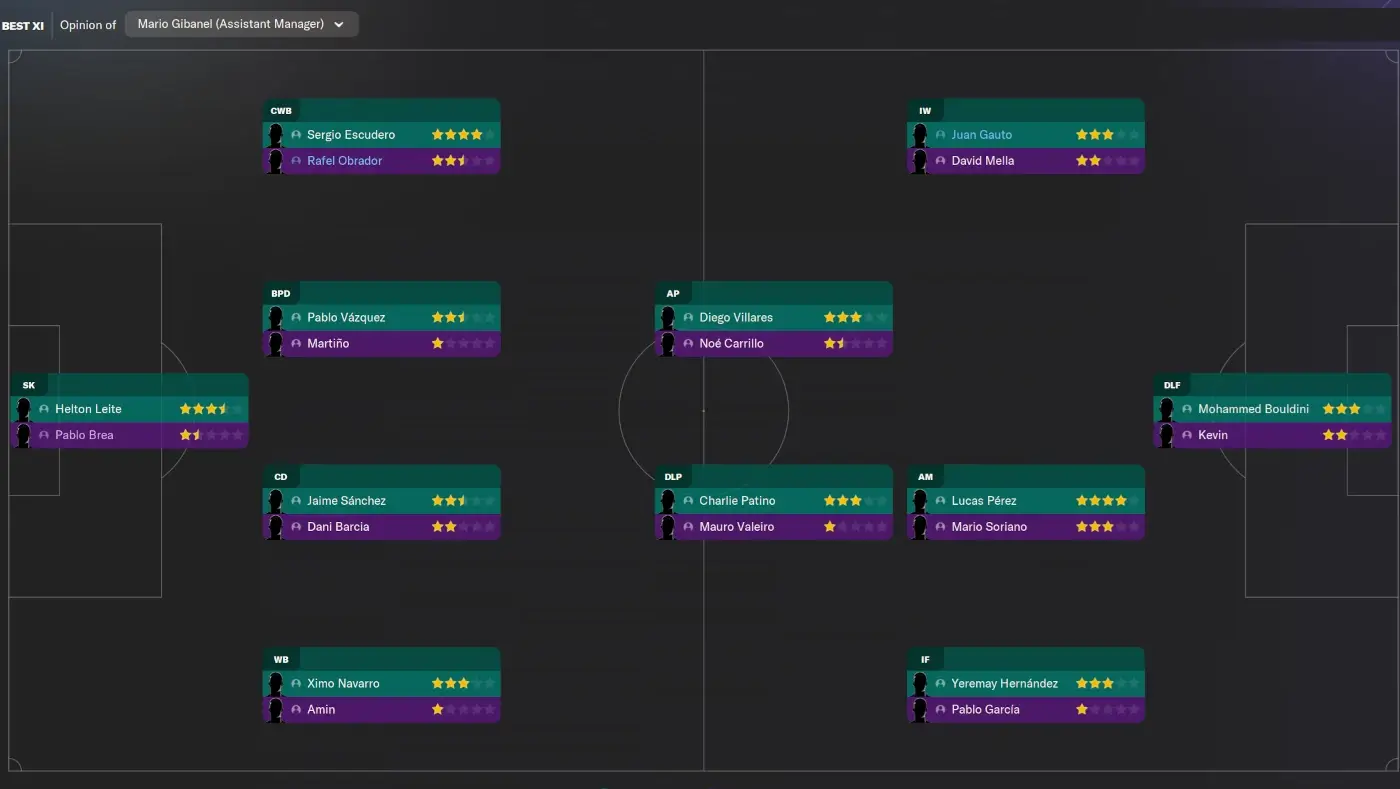
NB! Do remember that the star ratings you’ve been given and the staff’s opinion will be based on their level of judging player ability and knowledge of the team and its players. You will discover that two different staff members may value a player differently, and if you’ve signed a new player or a new assistant manager, it might take some time before the current and potential star rating, and their best role, is more accurately judged.
It’s worth to remember to take star ratings with a pinch of salt and instead consider prioritizing the level of key attributes for a position and role to judge the quality of a player.
READ MORE | How to conduct squad analysis in Football Manager
3.2 Squad Views
Another great alternative to the Team Report Card is to assess player by player by browsing through the Squad Overview by adding new columns of information and data.
In FM24 you can create your own squad views, take advantage of pre-made default custom views, such as the ‘General Info’ custom view, or download a megapack of custom squad views, for instance the one provided by us.
Personally, I can spend hours customizing different squad views for different objectives at the start of a new Football Manager release.
Although the default ‘General Info’ is a great basic squad view which let you get a quick insight to your squad’s best position and tactical role, along with other useful information about the players abilities or potential, represented via star ratings, as well transfer value and age, customizing different views with different objectives can save you both a lot of clicks and time spend browsing around FM for the correct information.
* The star rating is the assistant manager’s considered opinion of the player’s current abilities or potential, compared to other players within the same position. The star rating may fluctuate as the assistant manager gains more knowledge about the squad’s players, depending on their form or current performances.
Customized squad views will let you learn more about the players skills and provide you with unique information tailored to your squad.
- In this situation, you can always insert a column of the players’ best tactical role, their natural position and preferred foot, or create a more specific squad view which reveals all the players’ attributes to better judge player’s strengths and weaknesses within certain positions or in certain areas of the game, such as Determination, Decisions, Anticipation & other key attributes to your Club DNA and football philosophy, or a more general screen which splits up all the attributes per position or role. For instance, lining up attributes relevant to wingbacks and wingers next to each other, centre backs or strikers by coupling Dribbling, Crossing, Stamina and Off the ball next to each other, or Tackling, Marking, Heading and Concentration for central defenders.
- Create squad views based on statistical data or tailored towards certain areas of the game, e.g. training or set-pieces to analyze their performance or quickly make adjustments to their individual training, or identify who are the best corner takers, best at tracking opponents or enhance the process of squad selection by picking players who are in form by creating a specific match selection view that takes into account training performance, condition, match sharpness, morale, average rating and other basic statistical data such as minutes played, goals, assists and xG.
RELATED | Download Passion4FM’s Custom Views Megapack
3.3 Squad Comparison
The Comparison tool within the Squad Planner enables you to compare the level of your players with the rest of the league. The squad comparison tool is very handy when it comes to analyse your player’s abilities relating to certain attributes relevant to each strata of the pitch, e.g. in defensive third, midfield or attacking third.
You can browse the squad’s average level of attributes relevant for goalkeepers, defenders, midfielders or attackers and discover whether their abilities are under or over the average level within your league and thereby identify specific weaknesses within your squad.
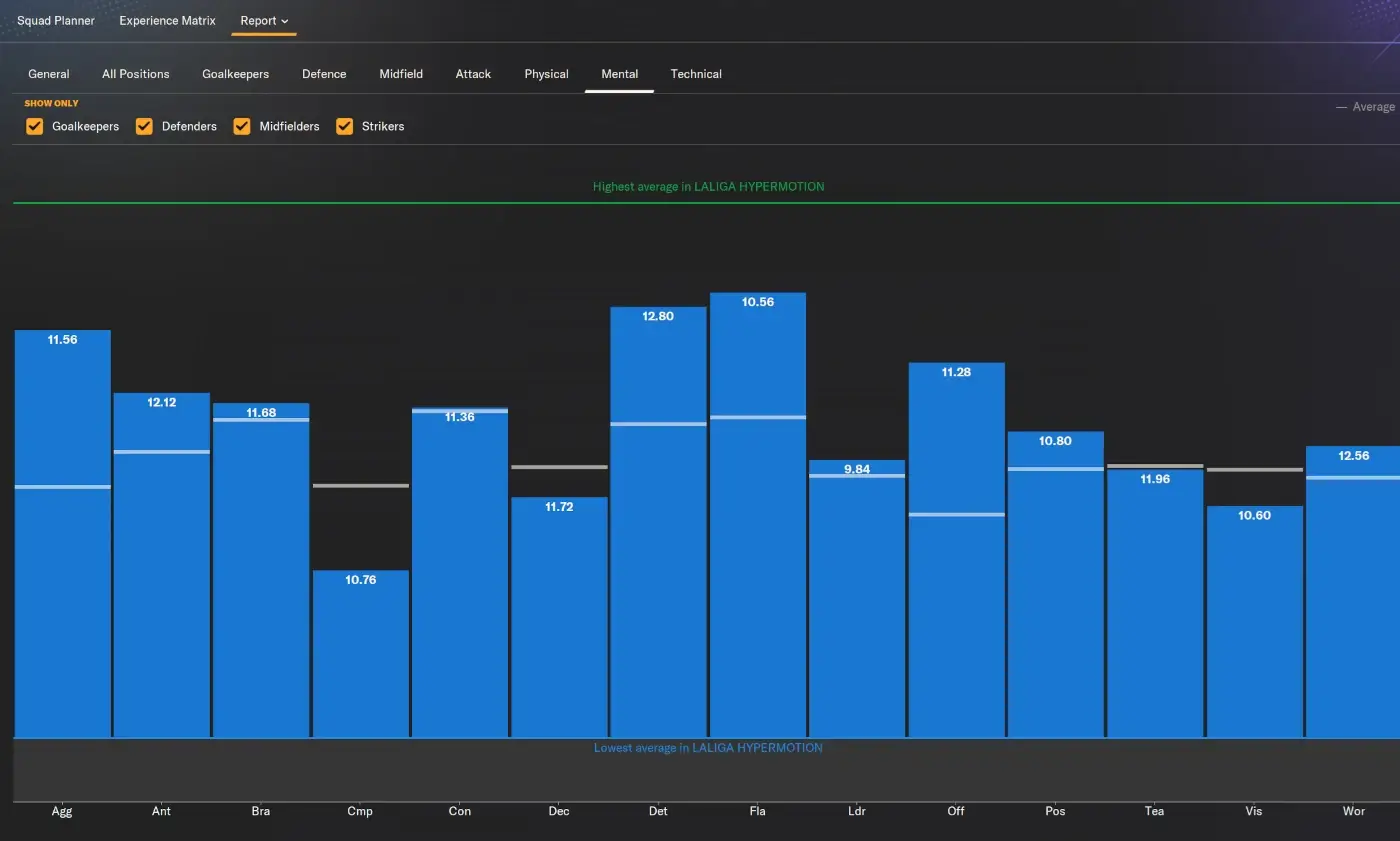
Then, you can use this information to determine what players the squad needs to either play that type of football you prefer, or which needs to be focused on when recruiting players to become more competitive to the rest of the clubs within your competition.
3.4 The Brilliance with the Squad Planner
The squad planner is essential both when analysing your current squad and in the future planning of your team with the next years in mind. Used right, the Squad Planner is a necessary tool that enables you to get valuable insight to the quality of your team now, or in the future.
Besides getting feedback from your assistant manager about everything relating to your squad and its players capabilities, the squad planner enables you to get a visual overview of the squad depth and be alerted of arising problems in specific positions before they arrive.
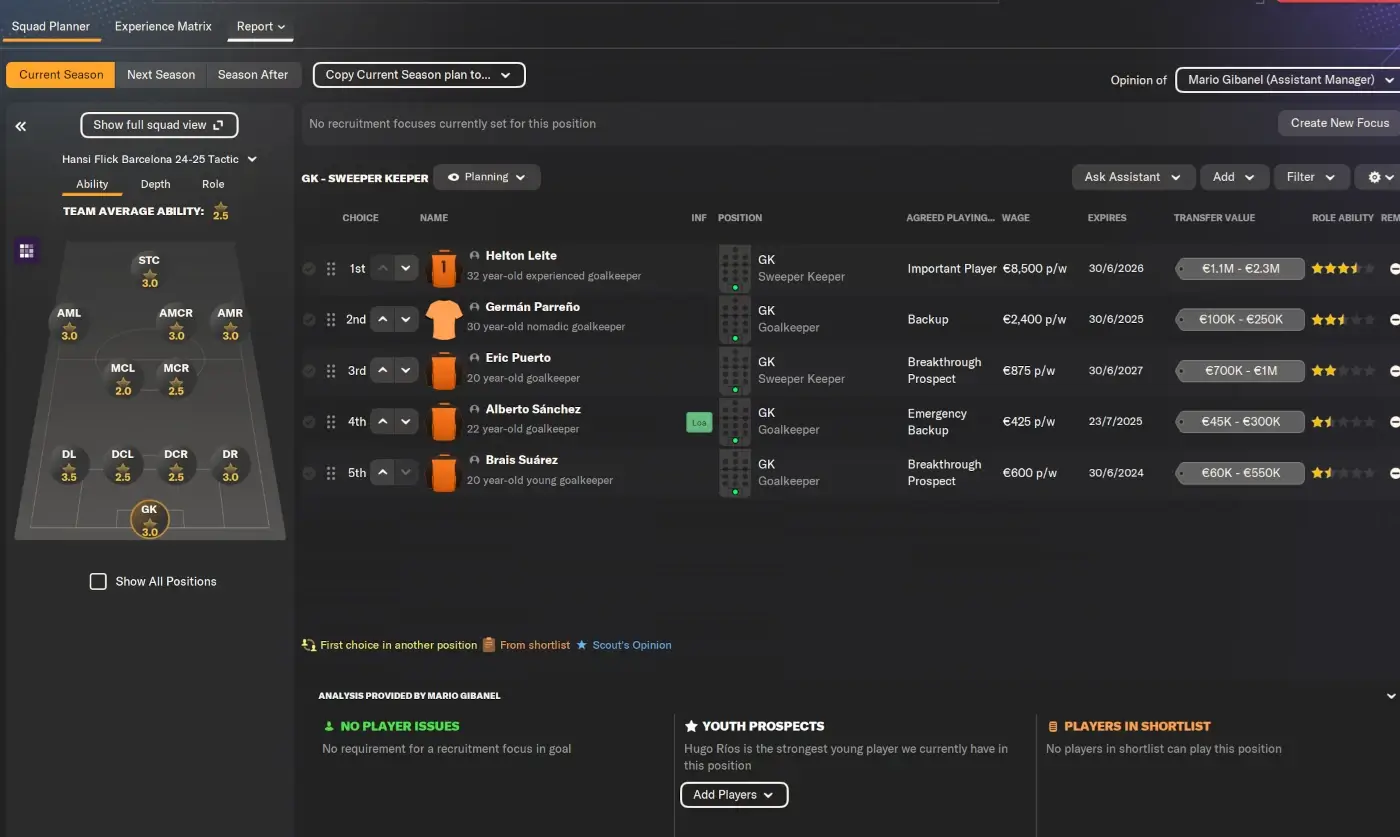
Once you have decided upon a formation, the Assistant Manager will provide his opinions on;
- Depth per position
- Team’s average abilities both overall and per position
- First Choice Players per role as selected within your tactics
Then you can browse these three screens for the current season, the next season or the season after to identify arising issues in the squad’s depth according to when contracts are set to expire.
A key function of the Squad Planner is to provide you with the opportunity to rank your players without sharing that knowledge to the player and thereby unsettle the player. You can move players up or down the list to determine the first choice, second choice and so on for each position.
A major part of the Squad Planner, besides outline the team’s depth is to get a visual representation of the average abilities per position and role represented through a star rating that may vary from 1.5 star to 5 stars.
However, even though you may have a couple of 4-star players within the team, the score considers all players abilities and calculates an average score resulting in a 3- or 3.5-star average ability must be considered as a great level. Even, a 2.5-star average score could be considered acceptable.
It’s only when the average score is at 2.5-star or below and you have only one or two players with over 3-star you should worry about the quality of your team, or its depth.
Spending some time browsing through each position to get a better picture of your squad will benefit you in the long run. Taking into account the players’ age, contract terms and agreed playing time will help you to make better decisions for the planning of your squad.
If you identify any immediate weaknesses within your squad or discover positions you need to strengthen for the future, you can use it to create targeted recruitment focuses for a certain position.
Apart from using the Squad Planner to analyse the current abilities and get a better insight to your team’s depth per position (or role), you can use the tool to visualize your future team by adding players you are interested in and has been added to your shortlist or is currently playing in one of your youth teams by adding players to the squad planner.
As you might expect, the Squad Planner is a very handy tool when it comes to squad building by providing you with an overview of the players of your disposal, or how your future team may look like if you manage to develop or sign new players of great abilities or high potential.
3.5 The Experience Matrix
Alongside the Squad Planner you have the Experience Matrix which provides you with a more visual representation of the players age and where on the develop path they are.
The experience matrix will take into account players current abilities compared to their age and potential ability to list players under four different stages;
- Development
- Emerging
- Peak are players who have reached the stage of their career where they won’t develop any more. Most often they are players between 23 and 31 who have reached their maximum potential.
- Experienced areplayers over the age of 31 who are reaching the latter stages of their career and will experience a decline in physical attributes
Throughout the different stages of development, you’ll be able to see how many players are classed as important players, are part of the overall squad depth or are considered as a youth player because they have low current abilities and currently plays for either the Reserves or Under-21 team.
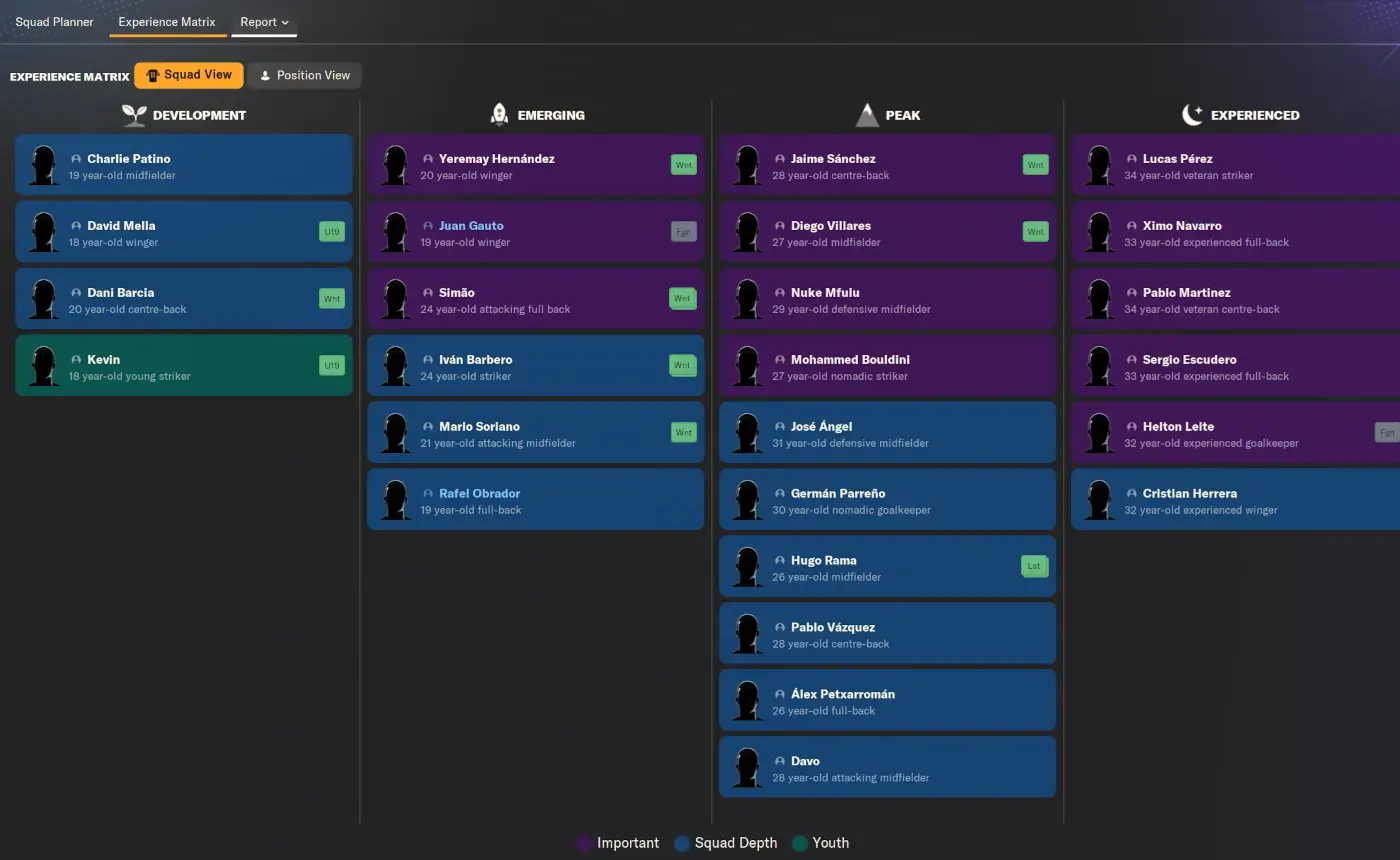
Use the Experience Matrix within the Squad Planner to get a visual understanding of players age and game experience. This knowledge will help you to create a pathway for your club’s most promising talents into the first team.
For instance, if you discover that most of your squad are labelled as Peak or Experienced players, you should set up recruitment focuses that looks to identify players between the age of 18 or 25 to replace your aging players.
3.6 Browse Player by Player
Once you have received an overview of the players at your disposal, you should spend some time learning more about the individual players at the club. To get a better understanding of all the individual players’ strengths and weaknesses I advise you to spend the next few weeks reading through the Coach Report for each player within your squad, even the most promising youth talents.
The coach report will give you a greater picture of pros and cons with the player, including hidden attributes and other useful information, such as his best role and position, making you able to try to get the best out of the player when creating your tactic.
Couple that with the information you receive from the level of his player attributes in technical, mental and physical attributes and you get a better picture of what the player is capable of.
Getting to know your players will be a continuous process over the next few weeks until you must finally decide on your starting XI for the first competitive match.
Regardless of how much time you use at day one to analyze your players it’s a great chance you will learn more about your players over the coming months as team’s and player’s performances becomes pivotal to your focus.
Chances are you might experience issues that forces you to shred your entire recruitment plan to pieces as you discover areas you need to strengthen and you’re forced to make tough decisions you’ve never anticipated at day one, or when entering the new club.
4. Re-Sign Players when you can!
Re-signing players will always offer several strategic benefits we shouldn’t overlook. In some ways, they could be labelled as the perfect signing you never made!
At day one on Football Manager, you should take a minute or two to identify players on an expiring contract. That includes both First Team players and those young talents found within your youth teams.
Re-signing players have a number of advantages you shouldn’t overlook!
Not only have the players built up partnerships and a mutual understanding of each other’s style of play through out the years they have played together – something that will maintain the team cohesion high and dressing room atmosphere on a positive side, unless there are conflicts or lots of newly integrated players who haven’t formed any relationships.
As real-life evidence has shown us, this consistency in player recruitment will over time enhance the team’s performances, as players already know the team’s system and style of play.
Economically, re-signing players may be more cost-effective than seeking new talent, as it reduces the uncertainty and risk associated with integrating newcomers.
Ultimately, retaining established players ensures the team remains competitive while cultivating long-term success.
As you’re gaining more knowledge about the players at your disposal you should pay attention to player’s contract status, happiness and wages.
Spending some time at day one to enter contract negotiations with key players or significant talents with high potential could be that hidden key for long-term success.
By browsing through all the players within your team to learn about their abilities and potential, you might have gained attention to certain players that you like to keep no matter the cost, players to offload and players you’re simply not sure of.
In the matter of re-signing players, there are a few questions I like to ask myself:
- Are there any important players on an expiring contract? If yes, offer them a new contract immediately.
- Or Trigger the Contract Extension clause if the player has one
- Are there any players on high wages that is playing at close to their fullest potential or might be surplus to requirements within the next seasons? If yes, consider transfer list the player immediately to potentially free up funds for a replacement, or let him get as much playing time as possible to maintain his value whilst you spend the next months to look for a replacement.
- Are there any promising talents with high potential that might become valuable players for the first team in the future? Offer him a better contract if possible. Then, promote him to the first team so he can train together with the first starters and thereby enhance the standard of his training. This is important if your youth facilities are poor, or you lack quality youth coaches. To ensure they get valuable match experience make them available to play for the Under-18 or Reserves and slowly introduce them to the first team by giving him 10 to 30 minutes here and there over the course of the season.
- Are there potential breakthrough prospects that you can’t promise regular playing time to aid his development? Put him on a Development List and loan him out. This is highly valuable if the league standard of playing in the Reserves or Under-18 team exceeds the player’s current abilities, which makes it far more advantageous to loan him out to a better club than let him “rot” in the youth side.
- Do you have any players out on loan that could be useful to the first team? Check their Loan Clause and Terminate loans of players that might become a significant player or become a useful back-up option. I often terminate loans for players at higher values and put him on a transfer list to try to increase the current transfer budget by offloading these players.
If you have found a handful players of significant qualities that fits your desired profile and where you wish to retain within the squad, you should consider entering contract negotiations.
Before entering contract negotiations it’s wise to get in touch with the player’s agent to initiate contract talks to inquire about his demands, and avoid the contract talks to breakdown before they begin.
DID YOU KNOW?!
It’s best to discuss the new contract with the agent first in order to determine whether the player is willing to sign the contract and what their demands are likely to be without potentially making the player and agent upset and unhappy.
By getting in touch with the agent via private chats you will learn about the player’s future plans, what he demands of wages, clauses or bonuses to stay, or what it would take from him and his agent to accept a new contract.
Are his contract demands, wages and bonuses affordable to you? Does the cost of the new contract fit your club’s financial structure? Or, do you need to look for a replacement as he isn’t interested in renewing the contract?
These are important questions to get the answer of early on, as it might change your entire scouting plan – where you need to look for a replacement for one of your club’s best players rather than scouting for wonderkids and young talents with high potential.
Check out this video by Football Manager YouTuber YGormy who takes a closer look at how he approaches day one in his FM24 Ajax rebuild.
5. Analyse Your Coaching Staff – Hire & Fire Appropriate Staff
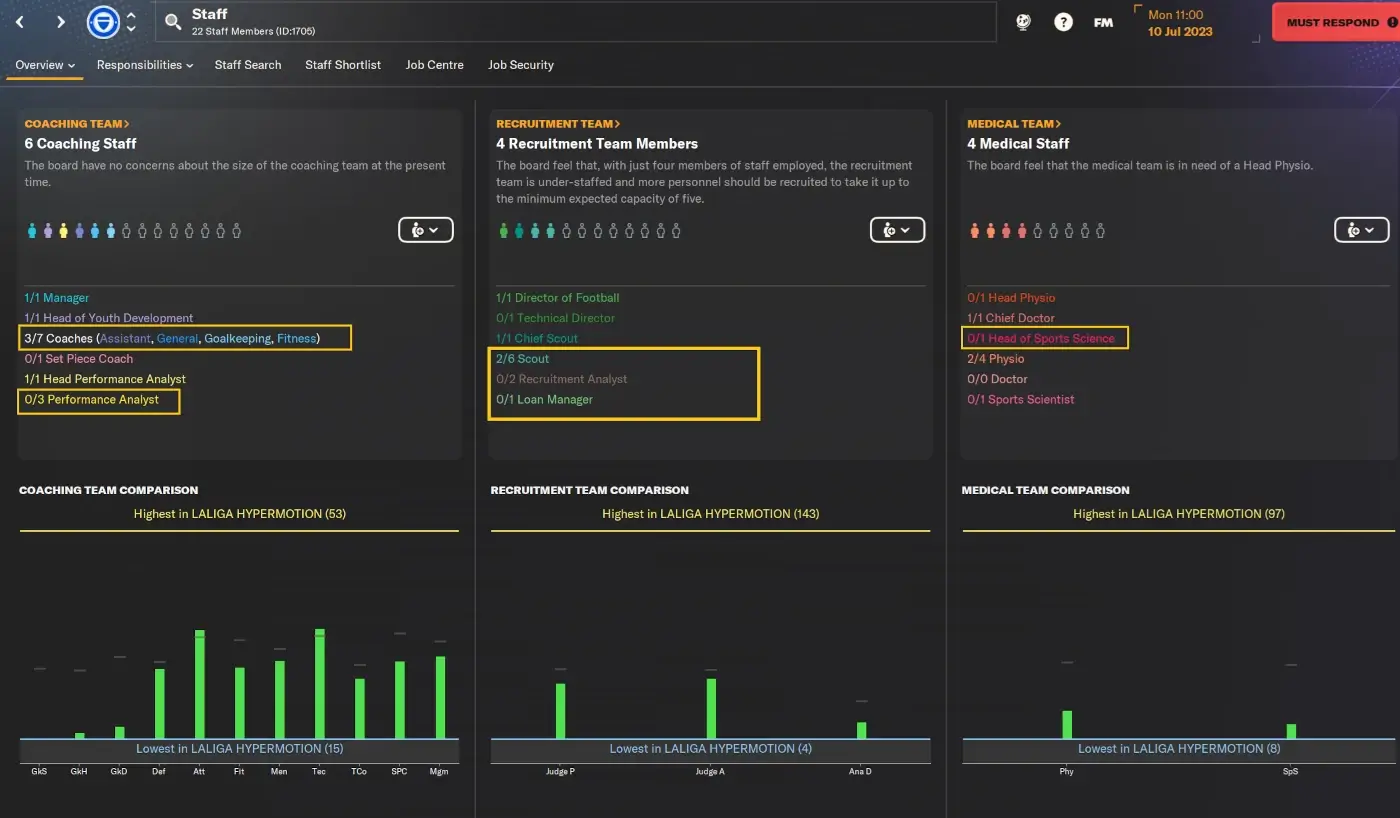
We can’t underestimate the influence of your team’s coaching staff has over the player’s progress. If you want to get the best out of your players, the coaching staff’s qualities is equally important as player’s potential and skills.
To increase the effect from the training sessions and take advantage of the club’s training facilities, signing quality coaches and other backroom staff that has the necessary skills to do the job they are in control of, is crucial.
Once you have spent some time familiarizing yourself with your new team, the focus moves towards analysing your club’s coaching staff and see if any improvements are needed.
By heading to the Staff Overview you will get a visual representation of the quality of your staff within all the three departments of the team’s staff.
From here, you can get a comparison of your current staff with the standard within your league as well as getting to know whether there are any concerns and positions you should look to recruit in.
The comparison graphs or the breakdown of the staff’s overall team attributes for each department (coaching, recruitment and medical) can be of great value as you analyse your backroom staff.
These graphs will alert you of significant problems – for instance if you’re team is below par in terms of qualities compared to the rest of the teams within your division.
By hovering your mouse over the different graphs relating to each attribute you will discover which team is best or worst within your league according to that specific training area.
You can use this information to poach staff from your competitors or get to know what it requires to get the best staff within your league.
When analysing the staff, you will need to identify any vacant positions and get a better understanding of the quality of your coaching and recruitment staff and try to learn whether there are holes in the backroom staff that could help you take the club to the next level.
Does your team have enough coaches or scouts to reach your objectives and future goals? Is the standard of the coaches good enough to make sure your best talents can develop into great players in the future? Or do you have enough scouts at your disposal to set up a scouting network that aligns with your transfer and recruitment policy.
At this stage, it’s useful to take a moment to think about your football philosophy and what you need of coaching staff to implement a certain Club DNA.
For instance, if you favour to develop youngsters, you want to improve your coaching staff with coaches with high Working with Youngster attribute. Or, if you prefer to sign players from specific nations, you should ensure you have scouts within your recruitment team that has knowledge of the specific countries or regions.
Then, if you prefer to leave signing players to your Director of Football, and your team does not have one, you should spend the first day searching for a Director of Football that could join the team. Or, if you considering using loans as a strategy to develop players, perhaps you will profit from a Loan Manager who can oversee their development and happiness and provide feedback of the player’s loan spell.
Over the years, we have written several different guides looking at how to find the best staff. Below is a quick list of notable articles that may be of value to you:
What about analysing the quality of the backroom staff for youth teams?
It’s equally important to maximize the number of staff allowed for all your teams as often as possible. To check how the quality of your youth team’s staff you can either choose to show all staff at the club and go through each staff profile one by one.
However, a similar page as the Staff Overview for the First Team will be found by clicking on:
Development Centre > Under 19s > Staff Overview (or the specific sub-category e.g Coaching)
5.1 You are fired!
At day one on Football Manager, I spend quite a lot of time sorting out the club’s backroom staff by hiring and firing coaches, scouts and other staff.
At a major club with great financial strength, I’m lenient to fire any staff that doesn’t reach the minimum qualifications to be at the club but firing staff, even if they agree to leave on a mutual termination, can become an expensive affair.
When assessing their qualities, they will be judged by their Personality, Reputation and required staff attributes according to their role and responsibilities but the staff comparison graphs can provide you with a great overview of their skills compared to the league’s average.
It will also be worth to consider their coaching qualifications and preferred formation. The first determines how far up the league levels they are allowed to coach at, whilst their preferred formation tells you about their experience at coaching a certain shape. What their skills and tendencies are will decide whether they’re a good fit for my team, and the tactical style I wish to incorporate at the club.
By firing staff you’ll free up positions within your backroom team that could ensure more qualified coaches, scouts or physios could be signed.
Place Adverts
In the Staff Overview you’ll get a visual representation of the maximum allowed staff and whether there are vacant positions. You can easily place advert for any vacant positions and begin the process of searching for new staff.
The job centre and the staff search screen are two other screens useful to visit as you try to replace vacant positions within your staff.
5.2 Recruit Quality Staff
In the next stage comes the important job of recruiting quality staff that can enhance training, provide accurate feedback and more detailed analysis that you can trust, or simply take charge of an area of the game you have no interest in.
As we mentioned above, you want to improve your coaching staff with the right staff that aligns to your tactics.
In Football Manager there are three key staff attributes relevant for all the best coaches:
- Determination
- Level of Discipline
- Motivation
- + their coaching skills relevant for their role (e.g. Fitness for Fitness coaches or Mental and Technical for coaches that shall lead training area: Possession – Technical)
Alongside their coaching skills comes their Personality which is especially important for youth coaches as the staff’s level of Professionalism, Ambitions, Sportsmanship, Handling Pressure and Adaptability may rub off onto the players while working with them daily at the training ground.
What each staff requires is unique to their role and you can quickly discover what each staff role requires by clicking on the ‘Important Attributes for’ within the staff profile.
If you wait on hitting the Continue button, you got the opportunity to search for staff that are unattached and be signed on a free transfer.
Rather than being left behind by your competitors, taking the effort of trying to poach quality coaches, scouts and other backroom staff without having to pay any additional fees can help you setup a quality backroom staff at no cost!
Although recruiting staff and improving the quality of the club’s backroom staff is a continuous process, I can spend a lot of effort trying to improve the backroom staff within the pre-season period.
Identifying coaches that can take the club to the next level will be desired. By using specific backroom staff search filters you can target the backroom staff for each staff role and thereby identify backroom staff both interested in joining your club and who can improve the current standards of coaching, recruiting or the medical aspects of the club.
Regardless of the standard of my team and my ambitions for the save, I try to improve my club’s backroom staff with:
- A Good Assistant Manager
- The best possible Head of Youth Development
- Coaches for every coaching responsibility
- Under-19s Manager & Other Youth Coaches
- Scouts
- Performance Analysts
- Physios
- Sports Scientists
Signing a Director of football, Technical director or Loan Manager isn’t needed if you’re managing in the lower leagues. To save money prioritize your financial resources around key staff that helps to improve the on-pitch performance and reduce the number of injuries.
5.2.1 How to find the best Assistant Manager?
Having an assistant manager you can trust is vital for the team’s performance and long-term success. Whether you are one who enjoys to micro-manage everything within your save, or like to delegate responsibilities such as handling team meetings, press conferences and allocating opposition instructions, the assistant manager’s role is essential.
From providing feedback about the players, their current and potential abilities to provide team selection advice, you need an assistant manager with a profile that fits your club’s football philosophy and tactics.
Regardless of how you consider using the staff, his personality, level of judging player ability and potential, motivation and people management are key requirements when searching for the best assistant manager as possible.
With a role that can oversee several departments within your club, what type of assistant manager you prefer is solely up to how you’ll imagine using him.
For instance, if you prefer to delegate the responsibilities of opposition instructions to your assistant manager, he requires good level of Tactical Knowledge as well as above average judging player ability. If you consider letting him handle team talks, he will require good level of Motivation.
When searching for a quality assistant manager that fits your team, you should prioritize an assistant manager with the similar preferred formation and tactical style as the one you wish to incorporate at your new club.
This will be crucial if you imagine him to lead the team’s training. As you will discover, the assistant manager will provide suggestions with useful training sessions or training schedules that may fit the next opponent meaning his staff attributes will influence on the types of training sessions he plans. Something that can take training quite a different way than what you’d imagine.
For instance, if the Assistant Manager has a coaching preference towards Fitness, he will often prioritize physical training ahead of technical or tactical training sessions.
That means, if the current assistant manager doesn’t fit the profile of your football philosophy, you should consider terminating his contracts, if you can afford it, or wait out to his contract expires.
5.2.1 The Head of Youth Development
Another key staff is the head of youth development which is responsible for providing feedback on youth development and deliver reports about the progress of your youth players. At the same time, he is often responsible for handling the youth intake – resulting that his profile and skills should fit your club’s football philosophy. His personality and preferred formation can have a dramatic impact on the type of players you receive at the youth intake.
A good head of youth development requires top notch Working with Youngsters, high judging player ability and high judging potential ability to identify Juniors to bring through the club’s Academy.
In Football Manager, the Head of Youth Development is such a crucial role for youth development that I might need to terminate the contract of the current one and search for the best possible Head of Youth Development that ticks all the boxes to be labelled as a 5-star Head of Youth Development according to the standard of your team.
5.2.3 Improving the Recruitment Team with Scouts & Analysts
Finally, we must focus on improving the recruitment team, whether it being signing new scouts that increases the club’s scouting knowledge or add performance analysts that can deliver statistical data and key metrics that helps you to evaluate your team’s performances within the Data Hub.
That means, if you like to take advantage of the information and feedback about your team’s performance and receiving statistical data about your next opponents, you need to ensure the quality of your analysis team is decent.
However, this is also a matter of financial resources.
Although improving the coaching staff is a continuous process that never ends, you’ll be one step ahead by maximizing the number of allowed scouts within the first weeks of management.
Depending on the size of your club, it will give you more leeway when setting up scouting assignments and helps you to quickly identify more players quicker than if you are restricted to 2-3 scouts.
Keep in mind that 2 scouts will be send out to identify transfer prospects as soon as you create a recruitment focus of Top Priority – otherwise known as a short-term scouting focus.
By analysing and searching for staff that improves your backroom staff completes the fourth step in the process of mastering day one on Football Manager.
5.3 Setting up the Coaching Assignment
Whilst assessing the quality of the backroom staff, you should take the time before the season starts to set up the coaching assignments.
Here you’ll be allocating the different coaches at your disposal to their best training area and monitor the coaches’ workload to enhance player’s progress.
Editing the coaches’ assignments provides you with a wonderful insight into the quality of your coaching staff and how many you require to balance the workload and increase the coaching stars to a level where players develop at a greater rate.
You can find the opportunity to edit the coaching assignments hidden under:
Training < Coaches < Edit Coach Assignments
Here I’ll immediately get an overview of which areas in training (relating to my tactical style) needs better coaches, either to reduce the workload of some to improve the effect in training or get more qualified coaches with higher ratings to take charge of a specific area that’s highly important for your tactics.
When setting it up, my approach is to ensure each training area has a lead coach with the highest star rating as possible. This means that you should look to hire good tactical defending coaches, technical possession coaches and so on who are only responsible for a maximum of two training areas (ideally one), with a few general coaches that takes charge of multiple training areas to balance the workload of the lead coaches.
How many coaches you hire is of course a question about the club’s financial status and how much you can afford in wages to hire a sizeable coaching staff.
6. Use the Development Centre to Identify Potential First Team Starters
Unless you are managing your favourite team, entering a new team means you most likely has no knowledge of the club’s best talents or other young players with great potential.
Luckily, the Development Centre provides a great overview of all the players out on loan or within your youth teams and can help you to discover future first team starters.
With the recommendation from your Head of Youth Development about potential first team starters or ones to watch, the Development Centre provides a great insight into your club’s best talents, their progress and how far they can reach within the game, compared to your current players.
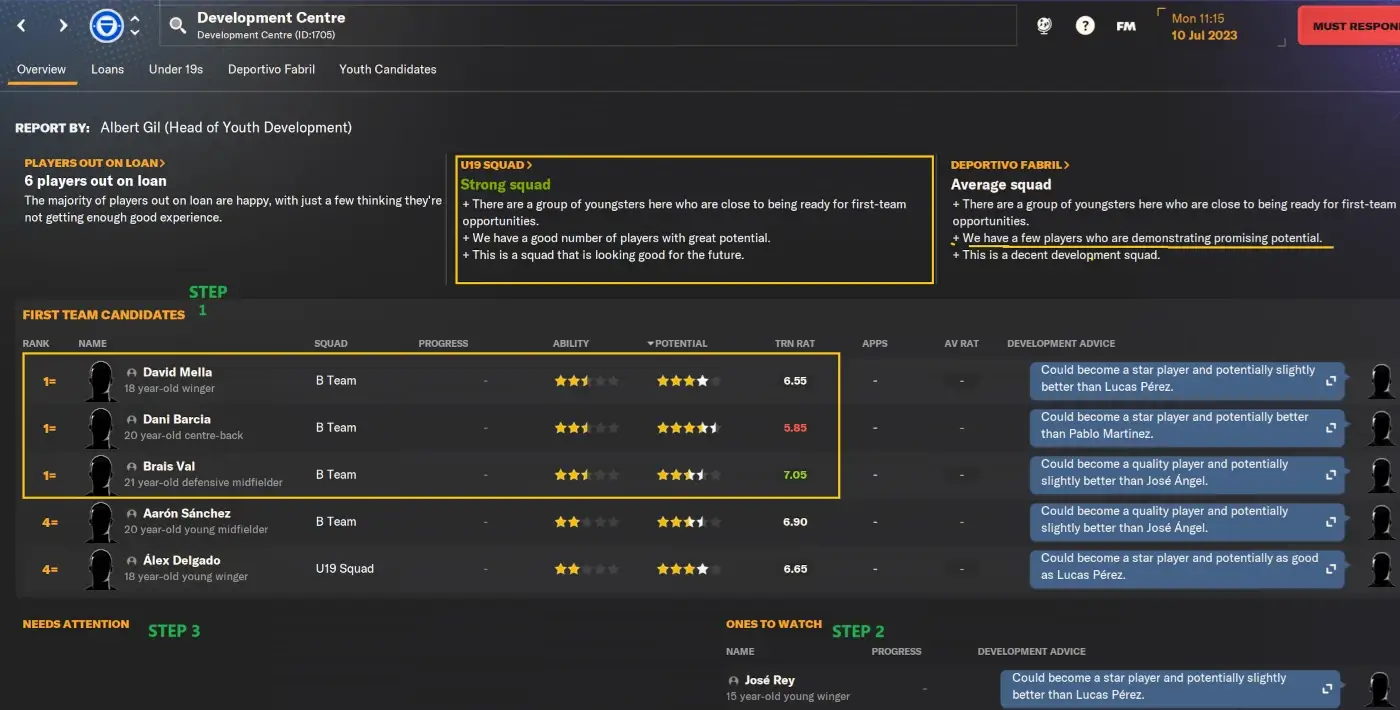
You can visit this page to regularly keep track of player’s training and development or use it to identify players that could be suitable prospects to be promoted to the next level to further enhance their development as the season advances.
The Development Centre is split into different departments that helps you to get to know all your players that’s outside the first team.
6.1 First Team Candidates
The overview of ‘First Team Candidates’ provides you with a breakdown of the best talents at the moment who are closest to First Team level. These players should be monitored with a keen eye and requires your action in near future.
Use the list of First Team Candidates to identify breakthrough talents that can improve the current first team’s squad depth or look to the club’s best talents when you find yourself in the position of signing new players.
As a rule of thumb, it’s more cost efficient to promote within rather than signing new players at a high cost – especially if the current abilities are somehow similar, or the player within the youth team has higher potential and could reach further in the game.
However, it all depends on the players age and their abilities now to immediately make an impact. If you are in the market for a player who can improve your squad quality and the only player in this position is under the age of 18, it’s better to promote the players to the Reserves or B-team to ensure the players can develop at an appropriate level rather than promoting your best young players to the first team to only be warming the bench, or get negative experiences on the pitch.
If the players are around the age of 18 or above, but you do not have any place for them within the first team, they will be suitable to be send out on loan.
Regardless of how you approach youth development, ensuring they gain match minutes and experience is critical to their progress from the age of 18. Before that, training should be prioritized to a greater degree.
In these circumstances, you can place the player on the Development list and your Director of Football, or the one responsible for outgoing transfers for ‘Outgoing Development Loans’ will take care of finding a suitable club for these players.
You can keep track of all the players out on loan by visiting the Loans section.
RELATED | Football Manager Guide on How to use Loans to Develop Players
6.2 Needs Attention
The Needs Attention section within the Development Centre lists all players who might not be developing as well as they need to and requires your focus to bring them back on the right path.
Perhaps they are unhappy at the club, has trained badly over a long period of time and you should think about making changes to his development plan to continue his development if the plan is that he should reach their maximum potential.
It might require changing his individual training to make him happy, take the time to make some difficult decisions such as sending him out on loan or move him to another youth team to see if a change in his training environment can boost his progress further.
6.3 Ones to Watch
Another significant part of the Development Centre is its focus on the club’s most promising talents and ones to watch. This section provides you with a wonderful insight into the Under-18 players who are both progressing well and is worth to keep an eye on due to their significant potential to become a great player at the club a few years down the line.
In general, the Development Centre can be used to improve your squad without spending money as you look to your club’s academy for potential wonderkids. In addition, it provides useful information about the quality of the different youth squad and its players and helps you in the planning and execution of scouting for players.
For instance, if the quality of the youth team is poor with less players of significant potential, it might be worth setting up a youth recruitment focus that looks to identify young players under the age of 18.
6.4 Youth Intake Candidates
The role of the Development Centre is not only to help you keep track of the progress of the current under-21 players at Loan or within the Reserves or Under-18’s level, and the standard of the youth teams.
In the Development Centre, you’ll also be notified about the quality of the youth candidates arriving at the yearly youth intake. As the youth intake approaches, you’ll get a list of players coming through the club a few months before the yearly youth intake happens.
Browse our list of Football Manager’s youth intake dates to get to know when your countries youth intake starts, what to do to improve the quality, and how clubs generate new players, in this guide.
Once the new generation of youth candidates are generated, you’ll be able to browse a list of these young players – making you able to decide whether you want to keep them at the club or release them.
7. Setting up The Scouting Network & Searching for Players
Next on the list of important tasks to complete at day one is to begin planning your club’s recruitment policy and thereby set up your club’s scouting network.
At the earliest point as possible, you should picture what type of players you want to buy and what kind of players your team needs based on the squad depth, your tactics and required by the style of play you establish. Most often you will be ‘restricted’ by the objectives and visions within the Club Vision – unless you have a specific plan to increase the difficulty level of your save.
Within the pre-season period, it could be useful to create a foundation for your future scouting network by creating shortlists, begin the process of searching for players and set up scouting assignments to track down players who can improve your team.
7.1 Control Scouting
Before you can continue the pre-season you should ensure you got control of the club’s scouting duties.
Although you can come a long way by leaving the task of setting up recruitment focuses to your Chief Scout, or the Director of Football, depending on who has the highest Judging Player Potential, Judging Player Ability and People Management, you’ll profit from a more methodical approach by taking charge of scouting yourself.
Within Staff Responsibilities you can delegate the responsibility of Scouting to yourself, or the staff member you prefer.
Personally, I would like to have complete control over the scouting department. This is recommended if you want to establish a certain scouting network that targets specific scouting methods and tricks far more pinpointed than what your staff might do.
Head back to the Scouting tab within the Staff Responsibilities section and make sure you are in charge of ‘Assigning Scouts’.
By taking charge of assigning scouts, you’ll be able to set up recruitment focuses yourself. If handled by the chief scout or DoF, they will automatically set up recruitment focuses and assign scouts to whatever assignment they feels is best suited for your team.
They may prioritize competitions, nations or regions that differs to your initial plan.
The drawback is that the scouting assignment might be less valuable than the ones you set up yourself. Yet again, there are pros and cons with everything and you might experience your Chief Scout send scouts to regions, nations or competitions where you’re able to sign players from – as he will use his experience and knowledge to identify useful prospects.
7.1.1 What should scout happen when requesting reports?
Another setting that could have been present within the section about sorting your club’s staff responsibilities are what will happen when you request a scout report of a player.
At the bottom of the Scouting tab, you’ll have the opportunity to decide whether the player should be automatically added to the Shortlist, and for how long. Personally, I prefer to leave this to ‘Never’ as the Shortlist will quickly get overflooded by players you ask your scouts to increase knowledge of.
However, the next setting is crucial!
Beneath, you can determine how long the scouts shall watch the player when requesting scout reports.
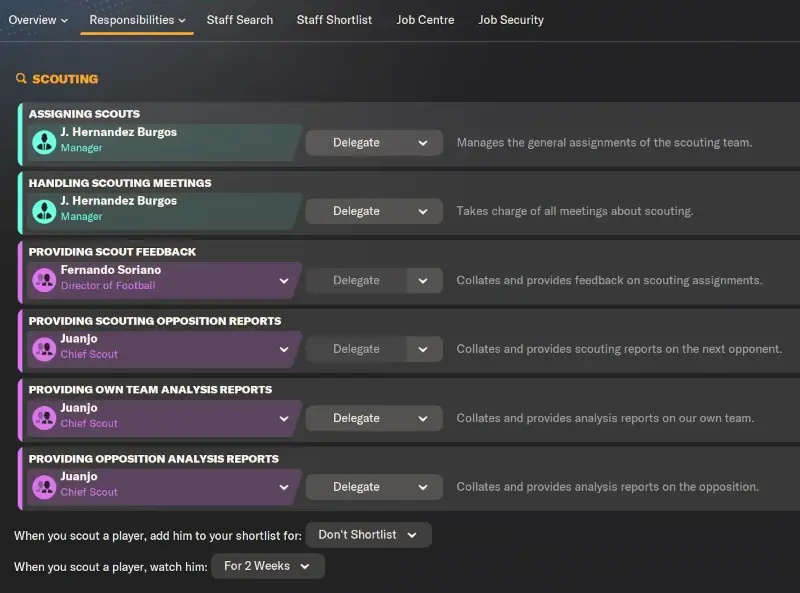
When clicking the ‘Get Scout Reports’ button it’s advisable to track the player for a certain time to gain a deeper understanding of the players contract terms, qualities and other hidden attributes. Personally, I like to edit the setting from 1 Week to 2 Weeks but you can also scout the player for a certain number of matches, which will take quite some time to finish the scout report.
Personally, I favour to get a quick and rather basic scout report delivered. Then, I can decide whether the player justifies spending more resources to gain a deeper understanding of his strengths and weaknesses, including his current abilities and a more accurate judgement of his potential ability.
You wouldn’t do anything wrong by selecting the default 1 Week. Just remember that the scout report is not 100% finished and the star rating or scout recommendation score you receive about the player can vary distinctively from how the scout will rate him after watching him over a longer time period.
7.2 Determining the Club’s Scouting Range
Your club’s scouting range will determine how far your recruitment team can look for players and how many players possible to find through player searches and in results from recruitment focuses.
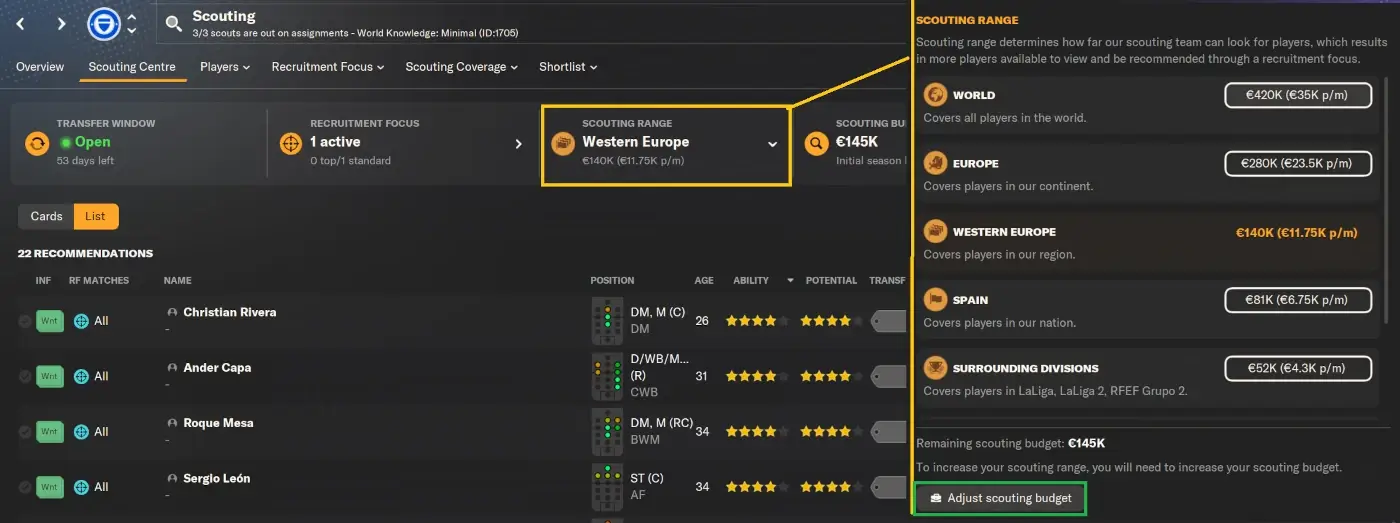
What level of scouting range available to you at the beginning of the save will depend on the size of the club and its financial resources.
In Football Manager there will be seven different tiers of scouting ranges capable of upgrading or downgrading to.
At the top you’ll have the opportunity to scout the entire world, meanwhile down the tiers you’ll be restricted to scout only regions, nearby divisions or your local league.
What’s available to you is determined by your club’s scouting budget. To generate more leeway in your scouting business, you can once per season adjust the scouting budget by removing funds from your club’s transfer budget.
This is purposeful if you wish to prioritize scouting for wonderkids rather than signing lot of players. In the end, it all depends on the size of your squad and its qualities.
Selecting the appropriate scouting range is one of the first decisions I take when coming into a new club. Here I’m no stranger to spending a few extra bucks on upgrading to the highest possible scouting range resulting in more players available in Players Found.
However, it’s not advantageous to select a higher scouting package than what you require in terms of the level of players you can attract (both in regard to their skills and the financial side of approaching them). It all depends on the nation’s, clubs’ and the reputation of your league and which players that may be interested in joining your club.
7.3 Creating Recruitment Focus
Once entering a new club your club’s scouting knowledge will be limited and the number of players found within the player search is most often far apart from the maximum number of players loaded. To quickly get recommendations of players popping up in the Scouting Centre, you can create a very generic recruitment focus which shall last for the first weeks of management before assigning scouts to more specific recruitment focuses.
At this point, you will ask your scouts to travel within your allowed scouting range (as revealed in the Scouting Centre) and identify as many players as possible to get a quick insight into potential signings and transfer targets.
If you have a limited number of scouts at your disposal, I recommend cancelling any existing recruitment focuses so you can ensure all your available scouts will participate in the duty of delivering reports to this generic scouting focus.
To create this generic recruitment focus, simply head to the Recruitment Focus tab within the Scouting Centre and go through this step-by-step process:
- Create New Recruitment Focus
- Choose Any Positions for Any Tactic
- Keep the default settings within the Main Details
- Keep Priority at Standard
- Click The Any button on Assign Scouts
– Untick Assign Any Scouts
– Select Every Scout
– Click Confirm - Click Confirm
In the list of Recruitment Focuses a Standard Focus called ‘ALL’ will be created. It will automatically add all players the players have some knowledge of, but more recommendations will quickly be included as the days passes by.

Then, as the season begins, you can cancel this Standard Recruitment Focus and make scouting more specified towards positions you are weak in, add recruitment focuses that fits your transfer and recruitment policy or look to enhance the knowledge of certain countries or regions to
7.4 Creating Shortlists
At day one, you should also prioritize some efforts at creating shortlists for the future so you can quickly keep track of potential signings you’ve found when searching for players.
At this point, I like to create a few different shortlists but which ones I create depends on the transfer policy I wish to incorporate, the players I need for the future and how much money I got available.
Normally we can create these types of shortlists that will be of value regardless of your transfer policy:
- Free Agents
- Under-18s
- Under-23s
- Shortlist per position e.g GKs, Defenders, Midfielders, Wingers & Strikers
- Bargains Under €5mill
DID YOU KNOW?
To ease the process of finding players, we have published several shortlists which you can download, such as our massive shortlist of FM24 Wonderkids. We have also created a shortlist of the best cheap hidden wonderkids in Football Manager 2024, or FM24 bargains available for less than €10mill.
7.5 Searching for Players
Although your scouting knowledge and pool of players found is somehow limited for the first few weeks until you have tried to extend your club’s scouting knowledge by assigning scouts to different corners of the world, you can use the first day of management to identify unattached players on free transfers or players on expiring contracts that could improve the team.
The same applies here as for poaching staff!
Be hands on and act early to ensure you are not being left behind by your competitors in your quest to find players who can be sold for profit later on.
Spending some extra time browsing through the available players within your range can be the first step to future success. Perhaps you find a player with better current abilities, or a back-up option that improves the squad depth at no extra cost?!
The search for players will never stop. In this event, you’ll profit from being creative in your search for potential signings. Use recruitment focuses wisely to look for players both in the long-term and short-term or take advantage of specific search filters to identify prospects that fits your profile.
In Football Manager, the opportunities to scout for players are endless! You can get a greater insight into some of the scouting methods to identify the best wonderkids and quality newgens in this guide to scouting for wonderkids.
7.6 Spy on Contracts & Clauses
Identifying potential signings at the earliest point possible can save you a lot of money. Searching for players who can strengthen your squad can be a time-consuming matter but if you know what to look for you can find both hidden gems and bargains that may strengthen your club’s financial side over the long run.
In Football Manager, it may pay off to spy on contracts and clauses to identify players who can be bought for a limited fee.
Take some time to browse through your player pool and sort by players contract expiry, minimum fee release clause, minimum asking price and transfer status.
7.6.1 Poach Free Agents & Approach to Sign Talents
Perhaps you are fortunate to find young talents who are too young to have signed a professional contract and are available on approach to sign, and has the potential to become a brilliant player with the next years in mind.
Or, you can improve your team with an experienced player available on a free transfer, who can benefit the club when it comes to mentoring of the club’s best young players!
To search for players on free transfer simply select:
- Go to Scouting > Players > Players in range
- Make sure the button Interested in Transfer is Ticked
- Click Edit Search
- Keep the Age range
- Change Contract Status from Any to ‘Unattached’
- Click Ok
*Make sure Any are set for both transfer status and loan status. - In the Players Found, browse by Reputation (you’ll need to add this column by customizing the current view.
- Browse the player’s profile
- Get scout reports of the players of interest or ‘Offer a Trial’ to gain knowledge about them.
You can save this search filter for future use by clicking the cog wheel in the bottom left corner of the Search Filter and click ‘Save current filter’.
7.6.2 Look for players on expiring contracts
When you have finished searching for the best free agents on Football Manager, you might want to spend some time searching for players with an expiring contract and could be available on an approach to sign within the next few months.
Create a new filter and modify the search filter by changing the Contract Status from Unattached to ‘Expiring 6 Months’ to identify potential transfer prospects that may be available on a free from January 1st or choose ‘Expiring 1 Year’ to get to know players that might be available on approach to sign from January 1st and could enter your team the following summer.
Then, all you must do is to gain knowledge of interesting prospects by getting scout reports or track their performance by adding them to a shortlist – making you better prepared for the upcoming transfer window.
7.6.3 Browse by players with Minimum Fee Release Clause
Finally, on the topic of finding suitable transfer objects, searching for players with a minimum fee release clause can help you to identify some unreal bargains.
Minimum fee release clauses are often automatically added to the contract terms of Spanish or Brazilian players but can also be found in contracts of players based in Portugal.
To learn about players’ minimum fee release clause there are some conditions that must be met.
First, you need to have a greater degree of knowledge of the player – meaning you need to request a scout report of the player until you have extensive knowledge of the player.
This can be achieved if you select a home nation in your Managerial Profile that increases the club’s scouting knowledge of the specified nations mentioned above.
Or you can focus your attention to setting up your scouting network by looking for scouts with great reputation, long experience in the game and who has an extensive knowledge of these nations.
Secondly, you need to customize the view of the Players Found page to include the Minimum Fee Release Clause column.
To edit the custom view, select:
- General Info (or the drop-down menu item besides Players Found)
- Hover over Custom & click Customize Current View
- Choose Filter – Scroll down to Minimum Fee Release Clause
- Click Add & Move it up/down according to where you want it to appear
- Click Ok
Do the same for adding the minimum asking price. You can find it under the Transfer Filter.
8. Upgrade when you can! | Interact with the board
Take every opportunity that comes your way is a great saying that you can take with you both in life and in Football Manager.
When starting a new save, we are all shooting for the stars with big dreams and ambitious thinking of everything we wish to do once entering a new club.
To help you get one step closer to reach all your goals establishing a good relationship with the board will give you a big push on your way to build a club into your liking!
Interacting with the board is necessary if you’re building a dynasty.
Upgrading training facilities, improving the club’s youth recruitment, request affiliations that will help your club grow both on and off the pitch, or increase the number of staff are all valid board requests to make!
Running down the chairmen office to make a lot of board requests early on in your managerial career can have its advantages and disadvantages.
Although I won’t recommend you to head straight to the boardroom to make several board requests at day one, monitoring the opportunities for upgrades at the club is important, and should be done regularly as you advance in the save!
As everything else in life, nothing comes easy.
It’s not like you can come into a new job and just demand lots of things, but monitoring the opportunities for upgrades in the club is important.
There are particular three things I look at within the pre-season period to upgrade:
- Increase Transfer Budget or Wage Budget; which will give me more freedom at the transfer market
- Look For Affiliate Clubs; to either enhance the scouting knowledge. If minor team, find a senior affiliate to get loanees from a bigger club or get an affiliate to generate more money from sponsorships and TV money.
- Increase the Staff Allowed. In the first event, you want to increase the number of scouts or number of coaches.
You can make board requests at:
Club Vision > Make Board Request > Networking / Finance / Staff
*If you’re a lower league club it might even be beneficial to have a Trial day to spot suitable players.
As you will notice, your board will be more lenient to deny any board requests that doesn’t fit the club’s visions and interacting with the board will be different from club to club.
Some clubs will have more ambitious chairmen’s who sees the benefits of upgrading training facilities, whilst others may find themselves in a more restricted financial position that makes upgrading facilities a struggle.
At the same time, when you’re new and inexperienced, you will need to prove your worth and try to gain their trust through commitment, loyalty, on-pitch performance and reaching the minimum objectives and goals from the board until certain board requests seems viable for the club.
In your quest to building a successful club knowing what areas worthy to upgrade is vital!
Personally, I would recommend you to focus the money and resources on upgrading the club’s training and youth facilities if creating a world-class youth academy is one of your main objectives.
If improving your club’s reputation is on your agenda, establishing connections with other clubs can be one of your missions. For instance, by requesting your board to look for a Senior Affiliate clubs.
At day one of your new save, take some time looking at your club’s current level of training and youth facilities and consider what’s the most important thing to upgrade once a little time has passed.
8.1 Adjust Transfer Budget & Wage Budget
For any sides in a good financial situation, you will be able to adjust your transfer budget from day one. Sometimes, you might discover that you can allocate a higher transfer budget by reducing the wage budget, or vice versa.
To adjust the transfer budget, head to the Transfers screen and click on the ‘Transfer Budget Remaining’ button.
To free up more funds and increase the transfer budget further you might discover that there are sell on clauses available to you where the board has negotiated a potential buyout fee that you can sell.
Once a clause can be sold, a yellow money icon € willbedisplayednext to the player’s name.
In these circumstances, you will discover that the buyout fee that is available is negotiated at a fee that is below the initial percentage agreement or for a reduced fee based on the number of appearances.
You will need to consider the short-term benefits of increasing the transfer budget now between the long-term prospect of receiving more money if he’s sold, or play enough matches.
In this situation, you will need to take into account the player’s current transfer value, his contract status and squad status to decide what’s purposeful in the current situation for the club.
9. Friendlies are your friend!
The pre-season is probably one of the most important periods within the season. As our guide to pre-season training details, this period has three different objectives:
- Build up match sharpness and prepare the players for the physical demands for the new season
- Make sure your players gain familiarity of your tactics
- Gel the squad together & improve the team’s morale and thereby their performances
In this situation, scheduling friendlies will be an important task to complete as early on as possible.
As you enter a new club your board might have set up a training camp with already agreed friendly matches to happen but do not be afraid to cancel any pre-arranged friendly matches and re-schedule friendlies that better suits you.
Playing friendly matches can be a great way at getting to know your players and what they are capable of. Identifying which roles, they are best used at, or whether they are familiar with the tactical instructions chosen. Perhaps you will use the pre-season period to tailor your team tactics to your players by slightly modifying team or player instructions, or as recommended by us, use friendly matches to build familiarity of your chosen tactics.
Before the season kicks off, it’s recommended to schedule around 6 to 8 friendly matches against various opponents. But how many you should assign depends on the length of the pre-season period and how fast the first competitive match comes. Perhaps you need to consider the first few league matches as part of the pre-season.
Just be aware that don’t schedule too many friendly fixtures either as all matches reduces the player’s conditions and increases the injury risk significantly.
However, if you match the player’s appropriately by balancing their game time, you will discover the pros outweigh the cons.
Personally, you should try to play around 50% of the total number of friendlies against weaker opponents to increase the players morale significantly. Then, you might want to play a few matches against teams with higher reputation to get some additional income or test your chosen tactics in the lead up to the first competitive match, whilst the last percentage of matches will go to playing against opponents around your own standard.
That means you’ll be playing a few weeks of two friendly matches per week.
In this event, I ensure that it’s one match for the first team and one where reserves or back-up players will play a more important role.
Throughout the pre-season, you should give around the similar number of match minutes to your entire team and ensure the match sharpness goes from lacking fitness to match fit. At the same time, the player’s morale should be improved from ‘Okay’ to at least ‘Very Good’.
By ensuring all your players receive match minutes within the pre-season by playing two matches a week, the whole squad will have improved their match sharpness and conditions in only one week.
How to arrange friendlies?
You can arrange friendly matches, cups or tours by:
Schedule < Arrange Friendly < Select Date < Select Venue < Select Opponent
*or you can also use the drop down arrow within the Calendar to arrange a friendly match.
Here you can choose between arranging Friendly Matches, Tours, Cup, Leagues, or multiple friendlies right away.
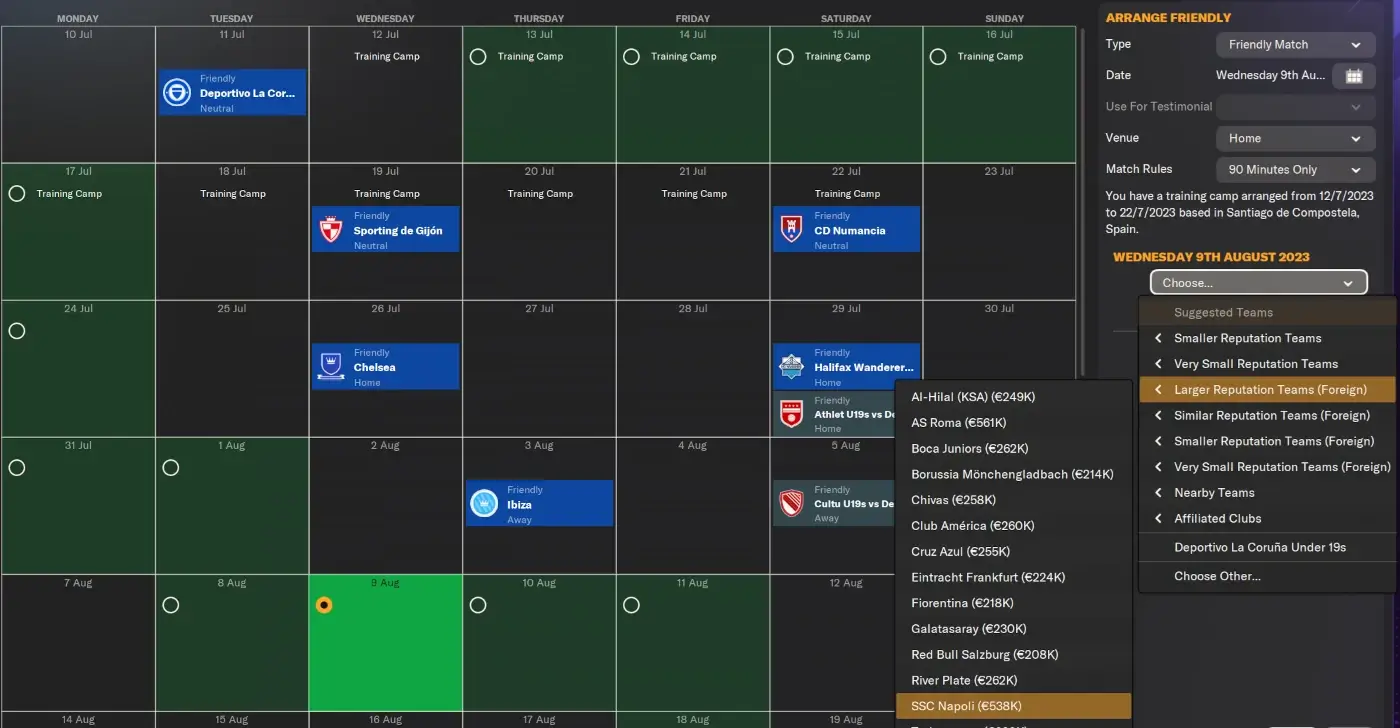
Normally I simply select single friendly matches or set up tours, as I prefer to replicate how the season will turn out. Having multiple matches in a short time will only get the players too jaded to give the best in the regular training sessions and requires more recovery in the days afterward.
You can learn more about how to get your players match fit and approach this important period of the season in our ultimate pre-season guide for Football Manager, as this covers every aspect of the pre-season more thoroughly.
10. How to approach Pre-Season Training?
Another required step at day one is to set up the pre-season training for the first weeks of management. At this point, it doesn’t matter that much if you’ve made some final decisions about your tactics but it’s worth committing to a preferred tactical style.
Your tactical style will set limitations to what type of training sessions you, or your assistant manager, should choose to use when creating training schedules for the rest of the season.
In the pre-season, how you approach training will be slightly different with more focus on improving the players’ physical conditions and tolerance to match fatigue than sessions that improves tactical familiarity among your players.
The ideal training schedule for pre-season looks to maximize the player’s match sharpness, team cohesion and tactical familiarity, alongside also increasing their happiness, as seen in the illustration below – a rather heavy pre-season training with two friendly fixtures a week.
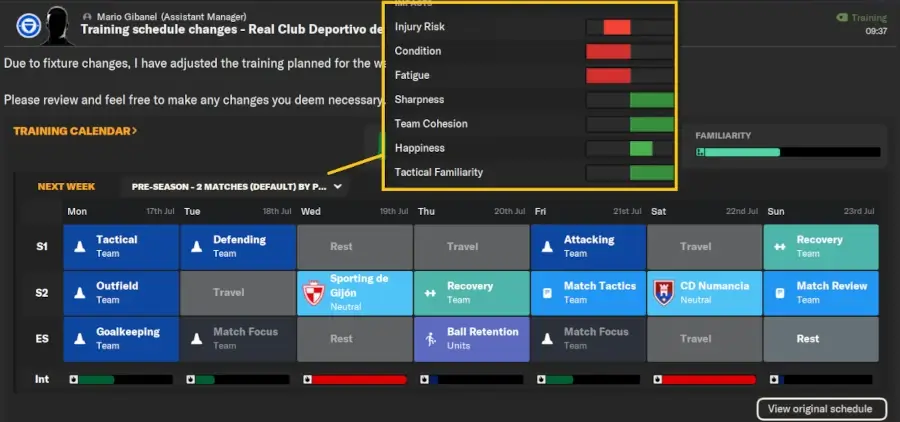
When setting up the first weeks of pre-season, you should prioritize Physical and General Training sessions ahead of more specialized training sessions such as Attacking, Defending or Technical training.
Although our ultimate guide to pre-season training covers this topic more in-depth, there are four types of training sessions you should put the most focus on within the first weeks of pre-season, are:
- General: Physical
- General: Overall
- General: Outfield
- Physical: Endurance
- Physical: Resistance
These training sessions looks to reduce the player’s condition which increases their overall fitness level and endurance.
Besides improving the player’s fitness and reduce their probability to become jaded later in the season, the pre-season training will also focus on improving the team’s tactical familiarity and player’s understanding of their player roles and duties.
At this point, the tactical familiarity levels to focus on is Mentality, Width and Position/Role/Duty along with Passing Style, Tempo and Trigger Press.
Training sessions that improve these specific tactical familiarity levels are:
- General: Overall
- General: Tactical
- General: Possession
- General: Defending
- Match Practice
- Tactical: Attacking Shadow Play & Defensive Shadow Play
10.1 Get Training Progress Feedback
As we enter the final stages of this guide to mastering day one on Football Manager, we need to include a valuable tip regarding receiving feedback on the training and development of your players.
In the Training section of Staff Responsibilities, you will discover that you can decide who shall lead the general and individual training of your First Team players, Reserves and Under-19s.
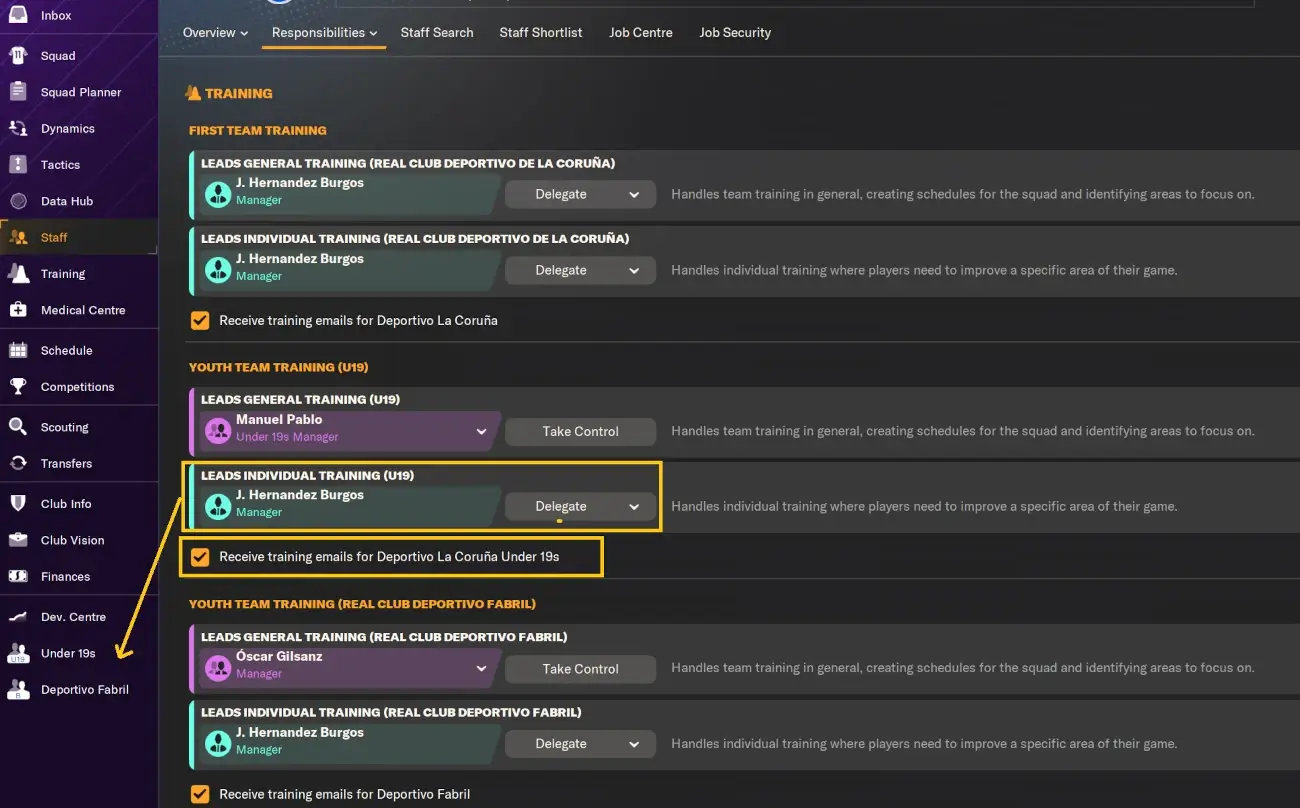
The default setting will see you run the general training of the First Team meanwhile the Reserves Manager and the Under-19s Manager will lead the training of the two other youth teams.
To be able to view the players that plays in the Under-19s or reserves you need to head to the Development Centre. However, if you take control of either Individual Training or General Training, these teams will be enabled in the main menu – saving you an extra click.
If you’re in charge, the Manager of the respective side will still set up training sessions according to the next opponents, but you will get the opportunity to edit specific sessions or adjust their Individual training rather than it will be automatically done.
Personally, I favour to be in control of the youth team’s individual training and likes to use one of my own training schedules that looks to maximize the player’s progress even though the default pre-made training schedules tend to do a decent job.
To get feedback on the player’s training, their progress and happiness, I always tick the button that ensures I receive training emails from both the Reserves and Under-19s to my Inbox.
If enabled, you will receive a weekly overview of the players within each team who have the best or worst training performance – giving me the opportunity to adjust their training load and intensity, if necessary.
At the same time, it presents you with the chance to praise or criticize a player’s training performance, which can both increase the happiness and morale – and thereby their performance in the coming matches.
Over the long run, praising the development of your youth players will establish positive relationships between you and the player, so it’s basically a win-win situation.
Every month I try to praise or criticize different players to avoid becoming too repetitive, as this will only dimmish the effect of praising or criticizing players.
10.2 Customizing Training Load
Setting up training is essentially a topic on its own as it’s lots to cover. However, before the pre-season can officially start, you should take a moment to set the training intensity and rest based on player’s condition.
Within the Rest section under Training, you will be presented with the opportunity to automate the process of setting up the desired training intensity for the entire team, or for specific players.

This means that if players haven’t played in the match and got superb conditions, some will train at Double Intensity training, meanwhile others may be working under Normal Intensity depending on their conditions. After matches, you might experience that players will be given a rest from training meanwhile others will work under a higher training intensity depending on whether there are training sessions assigned, or there are specific additional focuses within their individual training that they look to improve.
You can visit this screen to set training intensity based upon the physio’s recommendations relating to the current player conditions and match sharpness.
To maximize training, I like to ask all players with excellent conditions to train under double intensity, meanwhile a normal training intensity is given when the conditions drop to fair or good.
Players with very poor conditions will have no pitch or gym work and will be given a rest.
As the you play competitive matches, you will need to monitor the players condition and head back to the Rest page to edit the player’s individual training intensity.
This completes our guide to mastering day one on Football Manager. If you have any additional tips that we have omitted from including in this comprehensive guide to what you must do on your first day on a new Football Manager save, feel free to submit a comment.
Perhaps you have a specific methodology when entering the club of a brand-new career that differs from my strategy, or you like us to go more in-depth on a specific subject for Football Manager 2025 we want to get your inquires!
Stay tuned for more Football Manager guides likes this and other tutorials in the lead up to FM25 release! Thanks for reading and happy managing!


